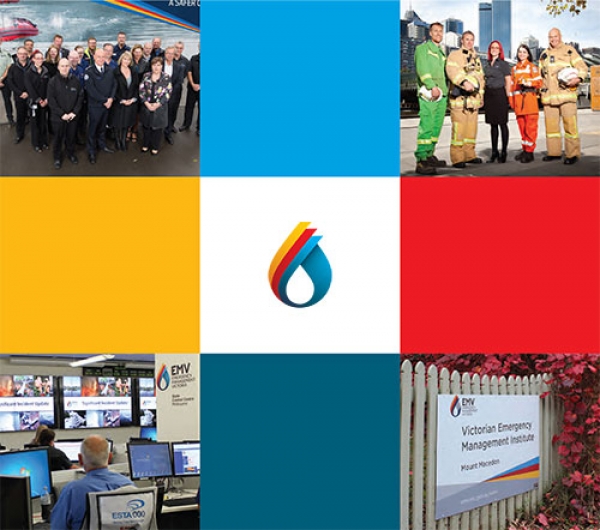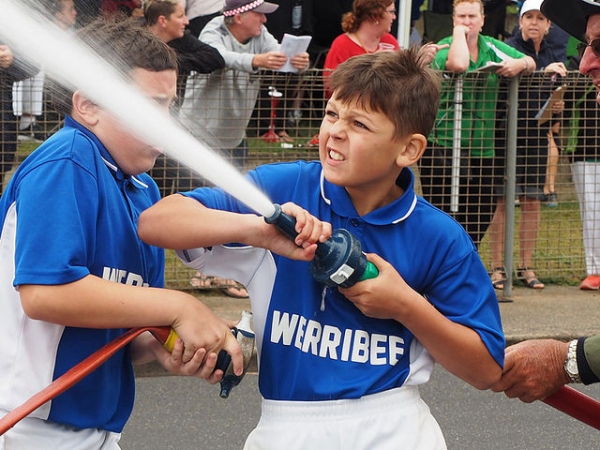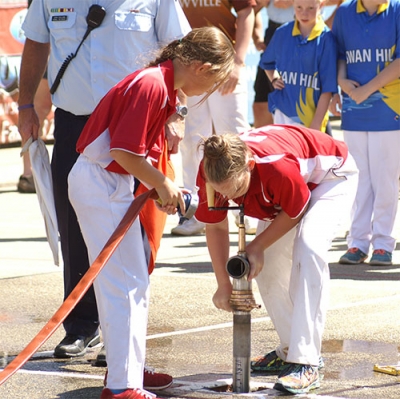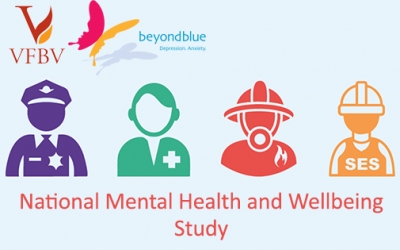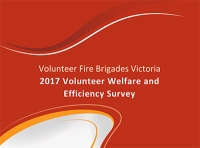
HomePage Featured (444)
Emergency Management Legislation Amendment Bill 2018
Written by Adam BarnettNote to Members: Emergency Management Legislation Amendment Bill 2018
This note seeks to bring to your attention some legislative amendments currently before the Victorian Parliament seeking to amend amongst other things the Emergency Management Act 2013 and consequential amendments to the CFA Act 1958, which for the most part are restricted to aspects relating to Regional and Municipal Fire Prevention committees and planning.
At a fundamental level the proposed legislative amendment removes the Regional and Municipal Fire Prevention Committees from the CFA legislation shifting the powers, responsibilities and arrangements previously assigned to CFA to now come under the EM Bill and Emergency Management Victoria (EMV).
VFBV became aware in recent days that this amendment Bill has now been introduced for consideration to the Victorian Legislative Assembly (Lower House) by Minister Merlino last week by way of a first reading speech on the 20th Feb 2018. Debate on the amendments is expected to resume on the 7th March before then proceeding to the Upper House.
Historical Issues
Following the introduction of IFMP (Integrated Fire Management Planning), arrangements surrounding Regional and Municipal fire prevention committees has been a topic of discussion amongst volunteers, CFA and within communities for quite some time.
For many years volunteers have been raising concerns including;
- The weakening of formal local engagement between Brigades/Groups, CFA and the Municipal fire prevention committee’s
- A reduced focus on wider community engagement in the development of Municipal fire prevention plans
- changes in volunteer representation to the Committee’s, and changes to meeting times and days that sometimes hinder volunteer/community involvement
- A reduced focus on the coordination and planning of fire breaks, and strategic fuel reduction plans for areas located within the municipality (but not located on public land)
These concerns have been discussed at length following changes to the composition and process of Municipal Emergency Management Planning Committees since about 2014 and both CFA and VFBV have previously identified that these and several other issues should be considered in any future legislative arrangements.
It would appear these concerns and previous input may have been lost along the journey, as they do not appear to have been addressed in the proposed legislative changes.
Proposed Advocacy
Having reviewed the amendments now outlined in the proposed Bill and consistent with concerns previously raised by volunteers with regard to Municipal Fire Prevention Planning and Municipal Emergency Management Planning it is VFBV’s intent to continue to advocate for:
- Ensuring the regulation/enforcement, audit and quality control arrangements are adequate and not eroded;
- Strengthening of formal arrangements to support local Brigade/Group engagement
- Ensuring that there is sufficient prescription and legislatively backed requirement for Municipal Emergency Management Plans to identify fire risks and drive mitigation treatments to address and prioritize the reduction of fire risk including land use, and the construction of fire breaks and fuel reduction on private land/and road/rail corridors within the municipality (The proposed new arrangements are silent on these matters)
- Effective arrangements to support compliance and accountability for the treatment of risks identified
- Ensuring mandatory volunteer and community engagement/consultation and representation
Next Steps
The proposed legislation is still before the Victorian Parliament and will need to be considered by the Upper House before it can be adopted. Although timing is impossible to predict, given that the proposed Bill is already before the Lower House, further debate and deliberations are likely to be within the coming weeks.
Given that there has been a long gap between the initial introduction of IFMP arrangements and initial discussions about changes to Regional and Municipal fire prevention committees you are encouraged to revisit this issue amongst your local networks; stocktake how the current arrangements are working and/or how they could be strengthened; and provide feedback as a priority if there are other issues you wish to raise regarding the proposed legislation.
Although the amendment Bill is already before Parliament, VFBV will continue to explore opportunity for consideration for amendment to the Bill. You are encouraged to engage in conversation at local MP level to ensure volunteer issues are understood.
At the bottom of this page, you can download the following attachments:
- VFBV News Note
- The Emergency Management Legislation Amendment Bill 2018
- Part IV of the CFA Act which it is proposed by this legislation to be repealed
You can also access further reading by clicking on the following links:
Junior Championships Results Feed and Photos
Written by Adam BarnettUpdate 02 March 2018: Full results, including all team times have been posted here: http://www.vfbv.com.au/index.php/champs/urban/results
Results from this weekends State Junior Championships in Warrnambool are being posted here: https://www.facebook.com/Volunteer-Fire-Brigades-Victoria-Championships-451309545285820/
You can also access a live photo feed from our Flickr account found here: https://flic.kr/s/aHsmfXtoY4
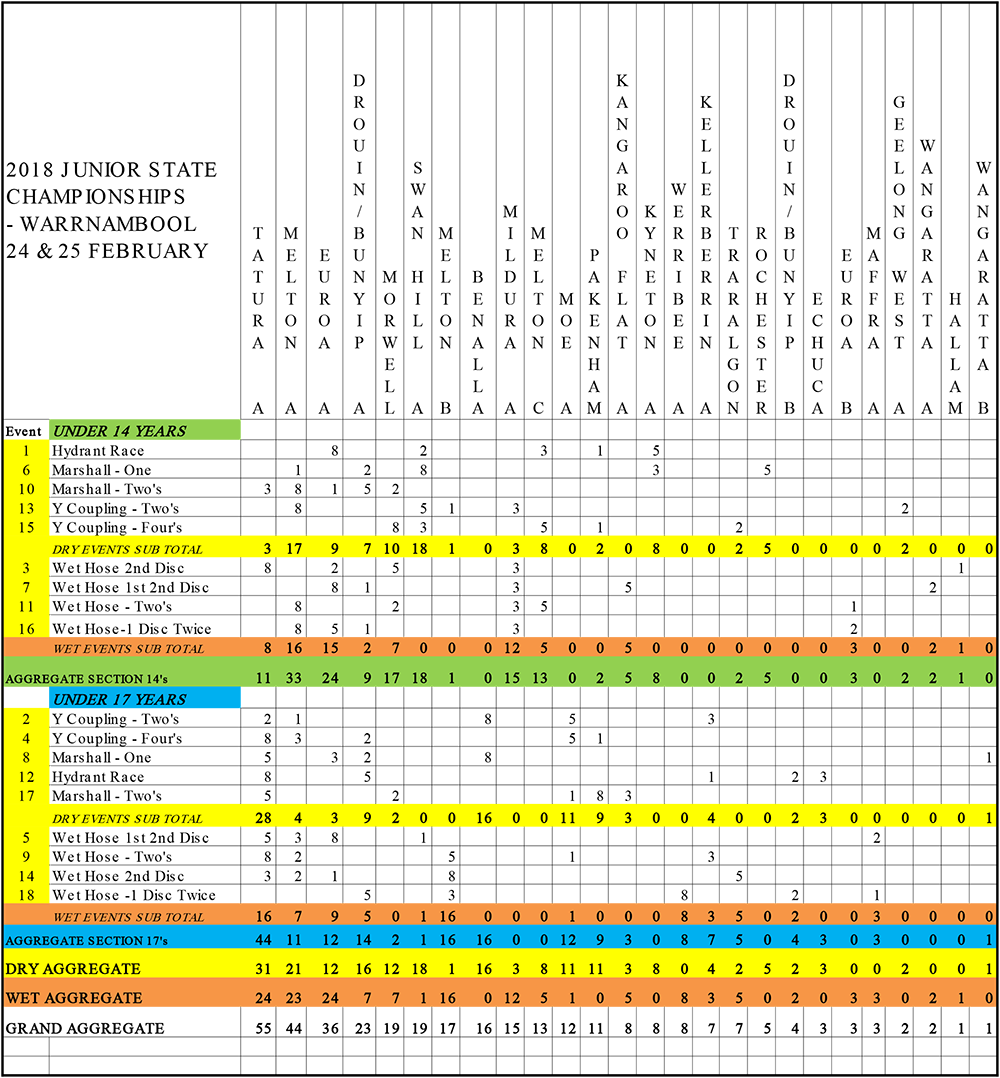
Final Results can be downloaded from the bottom of this page under Attachments.
VFBV State Junior Championships - This Weekend
Written by Adam BarnettA reminder for everyone to consider getting along to the VFBV State Urban Junior Championships to be held at Warrnambool this weekend (Saturday 24 and Sunday 25 February).
Come and see tomorrow’s CFA volunteers proudly demonstrate their skills and if you are not involved with the CFA juniors program or haven’t witnessed the value the VFBV Junior Championships provide for young volunteers to develop practical skills and to be actively involved in CFA then get along and be inspired.
This weekends Championships is being held at:
Friendly Societies Park
3350 Koroit Street
Warnambool
VicRoads Map 514 Ref G6
To learn more about the history of the Championships, please visit: http://www.vfbv.com.au/index.php/champs/championships/history
2018 VFBV State Urban Junior Championships
The Warrnambool Urban Fire Brigade is hosting the 2018 VFBV Urban Junior State Championships in Warrnambool, on 24/25 February 2018.
Urban junior fire brigade competitions have a proud 45-year history, with the annual State Championships attracting around 66 teams from across Victoria, and two teams as far away as Western Australia making 70 teams.
Program of Events
SATURDAY FEBRUARY 24th
COMMENCES AT 0830 HOURS
OFFICIALS TO REPORT IN AT 0815 HOURS
ROLL CALL OF BRIGADES (for Opening Parade) 0815 HOURS
OPENING PARADE - COMMENCES 0830 HOURS
0830 OFFICIAL OPENING
Event 1 Hydrant Race – One Competitor, Under 14 Years
Event 2 Y Coupling – Two Competitors, Under 17 Years
Event 3 Wet Hose Striking Second Disc – Four Competitors, Under 14 Years
Event 4 Y Coupling – Four Competitors, Under 17 Years
Event 5 Wet Hose Striking First & Second Discs – Four Competitors, Under 17 Years
Event 6 Marshall – One Competitor, Under 14 Years
Event 7 Wet Hose Striking First & Second Discs – Four Competitors, Under 14 Years
Event 8 Marshall – One Competitor, Under 17 Years
Event 9 Wet Hose – Two Competitors, Under 17 Years
Event 10 Marshall – Two Competitors, Under 14 Years
Event 11 Wet Hose – Two Competitors, Under 14 Years
SUNDAY FEBRUARY 25th
COMMENCES AT 0830 HOURS
OFFICIALS TO REPORT IN AT 0800 HOURS
ROLL CALL BRIGADES (for Events 12 & 13) AT 0815 HOURS
Event 12 Hydrant Race – One Competitor, Under 17 Years
Event 13 Y Coupling – Two Competitors, Under 14 Years
Event 14 Wet Hose Striking Second Disc – Four Competitors, Under 17 Years
Event 15 Y Coupling – Four Competitors, Under 14 Years
Event 16 Wet Hose Striking One Disc Twice – Four Competitors, Under 14 Years
Event 17 Marshall – Two Competitors, Under 17 Years
Event 18 Wet Hose Striking One Disc Twice – Four Competitors, Under 17 Years
Queensland Emergency Fire Service Superintendent Tim Watkins has opened up about his personal story.
He explains why mental health must be a focus in our workplaces, and he encourages anyone invited to participate in this groundbreaking survey to take the time to fill it out.
This is an opportunity for Australian emergency services personnel to again lead the world, not just in caring for communities, but in supporting themselves and their colleagues.
Reminder About the Survey
The world’s largest study on mental health across emergency services personnel is happening right here, right now.
Employees, volunteers and former employees from police, fire and rescue, ambulance and emergency services across Australia are being invited to participate in a short survey. In Victoria, VFBV has strongly advocated and supported CFA to be involved, and volunteers were sent invitations to participate on Friday 2nd February 2018. If you receive an invitation we encourage you to participate.
A representative random sample of CFA volunteers is being invited to participate in the survey. Participants have been selected at random and not on the basis of their wellbeing. This is to provide a representation of the needs of the whole police and emergency services sector. If you were randomly selected, you will have received an email at the email address recorded on CFA’s RMS system. For further information on the survey, please visit beyondblue.org.au/pesresearch and click on the ‘FAQs for participants’ link. You can also phone the research team on 1800 677 248 or email This email address is being protected from spambots. You need JavaScript enabled to view it.
Don’t miss out on having your say! Check your email to start the survey. Double check your SPAM or JUNK folders to see if you received it. The invitation were emailed on Friday 2nd February, and would have been sent from this address: (Beyond Blue PE Survey) This email address is being protected from spambots. You need JavaScript enabled to view it.
For further information, please click here to see a more detailed article.
I haven't received a link but want to be involved?
If you haven't received a link, but want to be involved, you can contact the research team at Roy Morgan, and they can provide you details on how you can participate. You can contact them by emailing: This email address is being protected from spambots. You need JavaScript enabled to view it.

Queensland Emergency Fire Service Superintendent Tim Watkins has opened up about his personal story.
TIM WATKINS: survey is time well spent for two reasons
No emergency services worker deserves to experience what Tim Watkins has been through.
The Queensland Emergency Fire Services Superintendent returned to work in Brisbane just months ago after almost two years dealing with post-traumatic stress disorder.
The condition was triggered by two emergency response events involving road fatalities in the early 1990s.
It took years for the after effects to manifest.
Physically and emotionally drained, Supt Watkins began taking consecutive days off work in 2015.
“I’d actually got to the point where I knew there was something wrong and I just didn’t care anymore,” Supt Watkins said.
“I was on a slippery slope and I decided to not even apply the brakes.
“It was very fortunate that two days after I made that decision someone actually said ‘mate, are you ok?’”
Those four words flicked a switch in Supt Watkins and lit up his long path of recovery.
“I lost count of the number of times I regarded suicide as a viable and attractive solution to the pain I was experiencing, even after my diagnosis of post-traumatic stress.
“It was only the love and support of my family and the medical treatment I was receiving which prevented me from carrying through with my decisions.
“Eventually, I had to decide if returning to work was something I could do or even wanted to do.”
Having returned to work, Supt Watkins was one of many emergency services personnel around the country randomly selected to complete beyondblue’s Answering the Call survey.
The largest study of its kind in the world, it will build a comprehensive picture of the mental health and wellbeing of police and emergency services personnel across Australia and the best ways to provide support.
Supt Watkins wanted to tell his story to encourage those selected to complete the survey who have not filled it out will take the time to do so.
“If I can help one person not get to the point I got to, then I think it’s worthwhile,” he said about the survey and its aims.
“It is time well spent for two reasons. Doing the survey, I realised that this is a bit of a self-help check. The second thing is that the information is going somewhere where it’s going to be valued and used.
“There is certainly a desire in our own organisation to do something about this.”
beyondblue’s Answering the Call survey
The world’s largest study on mental health across emergency services personnel is happening right here, right now.
Some of you have been invited to participate, with the aim of the beyondblue Answering the Call survey to collect invaluable information about the issues affecting the mental health and wellbeing of police and emergency services personnel.
The data will give beyondblue the evidence it needs to determine the best ways to provide support.
The survey investigates the prevalence of common mental health conditions such as anxiety and depression, as well as post-traumatic stress disorder and suicide risk.
It will also collect important information about stigma, use of support services and programs, and factors that impact on the mental health of police and emergency services personnel.
Since October 2017, about 100,000 current and former employees and volunteers in police and emergency services agencies across Australia have been invited to participate.
Check your email account now to see if you’ve been randomly selected to take part in the survey.

CFA’s capacity to mobilise
By Andrew Ford, VFBV Chief Executive Officer
February already! If you are like me, you will be wondering where the last few months have gone.
Naturally most people have been focussed on some demanding weather and fire situations and as we work our way through the summer fire season all efforts to date have demonstrated the great capacity of CFA and Victoria’s emergency sector to perform when the pressure is on.
CFA members should take heart in the fact that despite the current Government’s policy agenda to dismantle CFA, the community commentary has been one of appreciation and respect for the work CFA’s paid staff and volunteers do every day.
Like most summer periods, hot weather and high fire risk conditions plus first hand exposure to life threatening major fires for some, has prompted thankful recognition and constant public messages appreciating that Victoria’s capacity to deal with these major fires relies on CFA’s capacity to mobilise its huge, highly trained and professional volunteer resources whenever and wherever it is needed.
VEOHRC
Over the past weeks I have received many questions about what is happening to the Victorian Equal Opportunity and Human Rights Commission (VEOHRC) Independent Review into Equity and Diversity in CFA and MFB.
To recap, most people are aware that in 2017 the UFU instigated action in the Supreme Court seeking to prevent VEOHRC releasing its report publicly. The report was originally expected to be released mid 2017 but has been held up due to the UFU legal action. The Supreme Court provided a decision in early December 2017 dismissing the UFU application and confirming that the VEOHRC has acted within its powers in undertaking the work.
Following the Supreme Court dismissal of UFU’s application it was anticipated the VEOHRC report would be released sometime in January 2018, however in mid-January 2018 the UFU took further legal action appealing the Supreme Court decision in the Court of Appeal.
Subsequently the report has still not been released.
Our latest understanding is that the UFU’s appeal process continues and that VEOHRC is seeking to have this matter dealt with as quickly as possible.
The anxiety and frustration the delay is causing, particularly to people who participated in the review, is understood. VEOHRC is working through the UFU appeal process and a natural justice process to ensure any person whose reputation or rights may be adversely affected by a proposed adverse finding in the report is provided natural justice.
VFBV will continue to monitor the situation closely and hopefully the report is ready for release very soon.
I encourage anyone who needs support because of this delay to visit the VEOHRC website and follow the prompts to contact VEOHRC, seek support from our VFBV network and/or discuss your concerns with your local networks.
VFBV Volunteer Leadership Scholarship funding cut
On another matter I have also received many questions regarding the VFBV 2018 Volunteer Leadership Scholarship program. It frustrates me to say that this program has been cancelled for this year due to Government rejecting the VFBV funding bid which enabled the program to be offered to CFA volunteers and volunteers across the Victorian Emergency Sector.
VFBV received preliminary informal advice in late December 2017 that the funding for the Volunteer Leadership Scholarship was likely to be cut, and throughout January I have been seeking to convince Government officials to reconsider but have had no response. Whilst I am frustrated that there has not even been a formal advice to VFBV I do have to face the reality that the funding has been cut.
VFBV initiated this valuable volunteer leadership opportunity in 2010 and there have been 327 volunteer graduates over the eight years since the program commenced. VFBV developed and initiated the program fully funding it for many years and more recently expanding the number of CFA scholarships and offering scholarships to volunteers from SES, Coast Guard, Ambulance Victoria, Life Saving Victoria and St John through a combination of VFBV funds and a Victorian Government Valuing Volunteers Program(VVP) grant.
Despite the VFBV initiative receiving tremendous support and recognition from volunteers, agencies and members of the Ministerial Volunteer Consultative Forum and despite extremely positive support throughout this current VVP bidding and grants consideration process, the VFBV application was ultimately not supported at Ministerial level.
A combination of the Government cutting the funding for this project plus the late advice regarding funding rejection means that VFBV will not be able to run the full program nor even a scaled back program this year.
VFBV has enjoyed a long partnership with Chisholm Institute and we are now in discussions with them about how to approach future continuation of the program. VFBV will also be discussing alternative funding and fundraising strategies to ensure this program continues. Further information will be provided as soon as possible.
My apologies to all volunteers who had been anticipating the 2018 program. Formal notice will be sent to volunteers across other agencies in the coming days. I understand that the late cancellation notice will be disappointing for many, not the least being VFBV, Chisholm and our partners Emserv who all share a commitment to this program, however until now I have held off cancelling the 2018 program optimistically hoping that common sense would prevail and the funding would be approved.
Further information will be circulated to volunteers about how we work to encourage a rethink on the Government’s rejection of this important VFBV funding bid and also on the disappointing news that all VFBV 2018 Valuing Volunteer Program grant bids were rejected this year, apart from expanding our VFBV Welfare and Efficiency Survey to all Victorian emergency volunteers. Along with cutting the CFA funding to Fire Wise this does potentially signal an alarming trend.
BeyondBlue Survey
On page 11 in this edition of Fire Wise you will see an article promoting an important initiative being undertaken by BeyondBlue. The initiative, which involves a simple, totally anonymous survey, is seeking to improve mental health and wellbeing of emergency services personnel across Australia.
I fully support the work of Beyond Blue and encourage anyone who is contacted to participate with confidence that your details will be treated confidentially and that your input will be used genuinely to improve understanding and support for emergency service personnel, volunteer and paid staff alike.
This is an important and valuable BeyondBlue initiative and in addition I am pleased to advise that VFBV has commenced discussions with BeyondBlue to explore how we can build a close partnership to improve how we support our members in the areas of mental health and wellbeing. There will be more information regarding this to follow in future VFBV communications.
VFBV State Urban Junior Championships
Finally just a reminder for everyone to consider getting along to the VFBV State Urban Junior Championships to be held at Warrnambool on 24 and 25 February. Further details are provided elsewhere in Fire Wise.
Come and see tomorrow’s CFA volunteers proudly demonstrate their skills and if you are not involved with the CFA juniors program or haven’t witnessed the value the VFBV Junior Championships provide for young volunteers to develop practical skills and to be actively involved in CFA then get along and be inspired.
Scanner/listening set update
Due to the high number of changes including radio channel mapping and talk groups and fire ground channel reconfigurations across many Districts, CFA has agreed to a request by the VFBV/CFA Joint Communications & Technology Committee to provide a patch file that members can download and apply to their scanners.
This will save members having to manually update their sets. CFA Comms are working on the update file, and as soon as it is ready, we will let you know, and will also provide a copy for download on our website.
OUTAGE: On Thursday 7 December a small network configuration change to the Regional Radio Network was made by the network’s operator. One of these changes made use of a proprietary standard that is not part of the official P25 standard. This caused all Uniden Digital Scanners to fall silent, as they could not decode the stream. The cause of the issue was identified on Monday 11 December, and in discussions with CFA, CFA confirmed that it had requested an urgent rollback of the changes to the network that had been applied and it was expecting rollback to occur on the Tuesday.
On Tuesday 12 December, the changes were successfully rolled back, and services were all restored to normal. CFA has agreed to include a software update and bundle it with the previously mentioned patch file - that will include support for the propriety standard that was attempting to be rolled out. This will ensure scanners will not be affected by this problem again in the future. We will advise as soon as it is available.
Champs just weeks away
The State Urban Junior Championship will be conducted at Warrnambool over the weekend of 24 and 25 February 2018, with so far 68 teams from 45 brigades entered to compete including two teams from Kellerberrin, WA.
Altogether it is expected there will be up to 600 CFA junior members competing in the 18 events being held at Warrnambool.
VFBV reminds all Judges and Officials of the need for they to have applied for a Working With Children check prior to the Championships.
If not already organised, members can apply at workingwithchildren. vic.gov.au or to apply or update your details over the phone, please contact the VFBV office on 9886 1141.
Brigade Owned Vehicle Policy
The VFBV/CFA Joint Equipment & Infrastructure Committee continues to strongly advocate for implementation of changes to CFA’s Brigade Owned Vehicle Policies that were developed by a VFBV/CFA joint working party and endorsed by CFA several years ago.
The Committee believes the importance and reliance of Brigade Owned Vehicles and their impact and contribution on CFA’s operational capacity is not fully recognised or supported by current arrangements to the level commensurate with their vital importance and contribution to the State’s capacity.
The intent of the new policy was to provide greater support for Brigade Owned Vehicles, provide clarity and confidence in insurance coverage, streamlined registration processes as well as standardising maintenance arrangements and support subsidies which vary greatly across the State. The Committee has requested CFA advise of the new policies status and progress.
Vehicle Resource Tracking System Update
CFA has advised that the first batch of modems for installation into FCV’s has arrived, and fit has commenced to install the modems into nominated FCV’s. District OM’s have identified 439 vehicles across the State that will require installation, which involves adding an additional antenna and radio component to each vehicle. CFA has agreed to our request that fit out/installation technicians will visit each identified Brigade and carry out the works on-site. This ensures Brigades don’t have to drop off the vehicle anywhere and vehicles can remain in station and in service while the work is being performed. CFA have also confirmed that the works are fully funded by CFA at State level – and there will be no cost to Brigades.
The VFBV/CFA Joint Communications & Technology Committee has also reviewed CFA’s draft Resource Tracking Business Rule, and has provided feedback on the original version in October 2017, and additional feedback on a revised version on the 12th December. Members were generally comfortable with the proposed drafts, suggesting minor amendments to ensure: a requirement for CFA to advise all members on what will get tracked and how; inclusion in future new member and Induction programs so members are aware of what is reported; suggestions to ensure the data is maintained securely and safeguards in place to ensure the data is not misused; and explicit protections and safeguards in the business rule to protect members privacy and ensure that the data cannot be collected or used for disciplinary purposes. CFA has advised that it has supported and incorporated this feedback into its final version which it is expecting to submit to the CFA Executive Leadership for approval. CFA is hopeful that with roll-out and installation progressing on schedule, it will have an opportunity to start trialling the new resource tracking capability over the course of the current fire season.
beyondblue - Answering the Call - National Study

Have your say on the mental health of police and emergency services.
Even the most resilient police and emergency services worker and volunteer can be affected by the stress and trauma. That's why VFBV is supporting Answering the call - beyondblue's National Survey of Mental Health and Wellbeing of Police and Emergency Services Personnel.
We are working with beyondblue and CFA on a world-first national study to provide clear evidence about the issues affecting the mental health of police and emergency services personnel and identify the best ways to provide support.
Employees, volunteers and former employees from police, fire and rescue, ambulance and emergency services across Australia are being invited to participate in a short survey. In Victoria, VFBV has strongly advocated and supported CFA to be involved, and volunteers were sent invitations to participate in early February. If you receive an invitation we encourage you to participate.
beyondblue and VFBV are committed to working with organisations in the police and emergency services sector to ensure the survey results are used to improve the mental health and wellbeing of police and emergency services personnel.
The survey is completely voluntary and anonymous. Agencies will not see anyone's individual responses, as the online survey is being hosted by independent research organisation, Roy Morgan Research, and analysed independently by The University of Western Australia. No individual responses will be provided to CFA or VFBV.
A representative random sample of CFA volunteers is being invited to participate in the survey. Participants have been selected at random and not on the basis of their wellbeing. This is to provide a representation of the needs of the whole police and emergency services sector. If you were randomly selected, you will have received an email at the email address recorded on CFA's RMS system. For further information on the survey, please visit beyondblue.org.au/pesresearch and click on the 'FAQ's for participants' link. You can also phone the research team on 1800 677 248 or email This email address is being protected from spambots. You need JavaScript enabled to view it.
Don't miss out on having your say! Check your email to start the survey.
For more information visit this article on the VFBV website.
Training incidents safety reminder
Each quarter, the VFBV/ CFA Joint HR, Welfare and OH&S Committee monitors current injury and safety reports for trends.
Last quarter the Committee studied reported training incidents and near miss trends across regions and by the primary causations.
Injuries and near misses during training activities remains CFA’s highest reported injury activity. Training injury trends involve injuries to members’ knees, backs, fingers and legs. These injuries typically involve the impacts and/or contributing factors such as: Sprains/Stains, Handling of Hose lines and Branches, Slips, Trips & Falls, and Breathing apparatus drills.
The use of hose lines and branches is the most common piece of equipment involved which includes injuries from bowling hose resulting in being struck by the coupling or the branch when the line is charged. Approximately 62% of reporting training related incidents do not occur at training campuses but at localised less formal activities. CFA advise the training department are progressively working on improvements to raise awareness of training risks and training protocols.
On behalf of the Committee, members are reminded to perform dynamic risk assessments of all planned training activities, and encourage Brigades to appoint dedicated safety officers during activities to maintain a focus on safety during exercises. Pre training briefings to explain common injuries and preventions are highly effective at ensuring all activities maintain an active focus on safety. Thinking about safety isn’t just for those that organise training. Think about it when you are participating in it. Think about what you can do to ensure your activities and actions are safe – not just to you, but those around you. If you see something that isn’t right, or could be dangerous – speak up. It’s everyone’s responsibility.
2018 Brigade Delegate Development Program
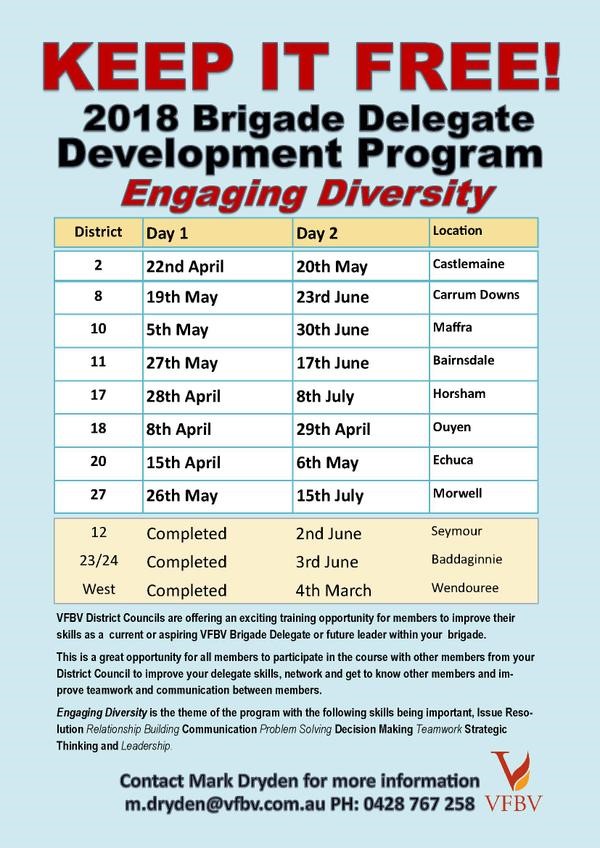
beyondblue - Answering the call - National Study
Written by Adam BarnettHave your say on the mental health of police and emergency services
The world’s largest study on mental health across emergency services personnel is happening right here, right now.
Some of you have been invited to participate, with the aim of the beyondblue Answering the Call survey to collect invaluable information about the issues affecting the mental health and wellbeing of police and emergency services personnel.
The data will give beyondblue the evidence it needs to determine the best ways to provide support.
The survey investigates the prevalence of common mental health conditions such as anxiety and depression, as well as post-traumatic stress disorder and suicide risk.
It will also collect important information about stigma, use of support services and programs, and factors that impact on the mental health of police and emergency services personnel.
Since October 2017, about 100,000 current and former employees and volunteers in police and emergency services agencies across Australia have been invited to participate.
Even the most resilient police and emergency services worker and volunteer can be affected by stress and trauma. That’s why VFBV is supporting Answering the call – beyondblue’s National Survey of Mental Health and Wellbeing of Police and Emergency Services Personnel.
We are working with beyondblue and CFA on a world-first national study to provide clear evidence about the issues affecting the mental health of police and emergency services personnel and identify the best ways to provide support.

Employees, volunteers and former employees from police, fire and rescue, ambulance and emergency services across Australia are being invited to participate in a short survey. In Victoria, VFBV has strongly advocated and supported CFA to be involved, and volunteers were sent invitations to participate on Friday 2nd February 2018. If you receive an invitation we encourage you to participate.
beyondblue and VFBV is committed to working with organisations in the police and emergency services sector to ensure the survey results are used to improve the mental health and wellbeing of police and emergency services personnel.
The survey is completely voluntary and anonymous. Agencies will not see anyone’s individual responses, as the online survey is being hosted by independent research organisation, Roy Morgan Research, and analysed independently by The University of Western Australia. No individual responses will be provided to CFA or VFBV.
A representative random sample of CFA volunteers is being invited to participate in the survey. Participants have been selected at random and not on the basis of their wellbeing. This is to provide a representation of the needs of the whole police and emergency services sector. If you were randomly selected, you will have received an email at the email address recorded on CFA’s RMS system. For further information on the survey, please visit beyondblue.org.au/pesresearch and click on the ‘FAQs for participants’ link. You can also phone the research team on 1800 677 248 or email This email address is being protected from spambots. You need JavaScript enabled to view it.
Don’t miss out on having your say! Check your email to start the survey. Double check your SPAM or JUNK folders to see if you received it. The invitation were emailed on Friday 2nd February, and would have been sent from this address: (Beyond Blue PE Survey) This email address is being protected from spambots. You need JavaScript enabled to view it.
A Frequently Asked Questions document can be found here
National Mental Health and Wellbeing Study of Police and Emergency Services
Project Overview
beyondblue is currently undertaking the National Mental Health and Wellbeing Study of Police and Emergency Services (Study). The Study aims to improve the mental health and wellbeing of police and emergency services personnel and reduce their risk of suicide by identifying evidence-based strategies focused on change at individual, organisational and systems levels. The findings of the completed Study will be used to inform the work of the beyondblue PES Program and influence policy and practice within police and emergency services and among governments responsible for these frontline services.
Rationale for the Study
Existing prevalence research on police and emergency services workforces in countries outside Australia shows that police and emergency services employees have higher rates of stress, depression, anxiety and PTSD, when compared with the general population. Research comparing police and emergency services’ suicide rates with general population suicide rates varies widely in its findings.
In Australia, a range of studies have been conducted to establish prevalence data and environmental data. Australian research has generally focused on a single population group (e.g. police officers in one agency), or issue (e.g. PTSD among fire-fighters in a given State). There is a lack of robust prevalence data examining the full range of common mental health issues and the spectrum of suicide risk (e.g. ideation, suicide attempts) experienced by police and emergency services personnel, including issues of co-morbidity of mental health conditions, and mental health conditions with substance misuse and physical health. Nor do we know which police and emergency services personnel are at greatest risk of experiencing a mental health condition or of experiencing suicidality or dying by suicide. There is also a dearth of data on the knowledge, attitudinal and behavioural factors of police and emergency services personnel that influence help-seeking for mental health conditions and that enables associations to be drawn about the individual, organisational and systems level risk and protective factors for mental health conditions and suicide. Measures of mental wellbeing are also lacking, and little is known about the influence of, and impact on, personal relationships and families.
The lack of appropriate data makes it difficult to understand the true nature of the mental health and wellbeing of this workforce (both serving and former), commonalities across and within specific cohorts, and the malleable factors that can be impacted on through appropriate interventions. These evidence gaps present critical risks for the development, implementation and evaluation of existing approaches within police and emergency services agencies that aim to improve mental health and reduce suicide risk among police and emergency services personnel.
There is a need for a comprehensive national dataset to establish essential baseline prevalence measures, individual knowledge, identify attitudinal and behavioural factors that influence help-seeking, and establish risk and protective factors for mental health, including the organisational policies and practices associated with mental health and suicide among police and emergency services personnel. This dataset is also required to design and develop appropriate interventions at an individual, organisational and systemic level.
The Study aims to fill this evidence gap in a way that ensures the police and emergency services sector is able to translate the research findings into practical actions that will lead to better mental health and decreased suicide risk for police and emergency services personnel in Australia.
The key components of the Study are:
- Mapping of existing research (complete)
- Advisory Group
- Phase 1: personal stories (complete)
- Phase 2: nationally representative survey
- Phase 3A: developing a knowledge translation plan
- Phase 3B: implementing the knowledge translation plan
Key components of the Study
Mapping of existing research The complex array of factors affecting the mental health of police and emergency services personnel, and long-standing recognition of the high-risk nature of their roles, means they are a heavily surveyed population. In order to ensure the Study fills existing knowledge gaps effectively, and avoids duplication and survey fatigue, beyondblue engaged Phoenix Australia to undertake a rapid mapping exercise of recent research relating to the mental health and suicide of police and emergency services personnel in Australia.
The mapping will be used to inform the approach to Phases 2 and 3 of the Study and enable beyondblue and the Study research team to more effectively engage with key researchers and agencies already contributing to the knowledge base in this field.
It should be noted a sizeable consultation process was undertaken to inform the design of the Study. This included interviews with 13 expert academics, 18 sector representatives, and 3 other stakeholders with relevant expertise, to seek advice on how to approach a range of aspects of the research such as the Study design, comparative datasets, target populations, stakeholder engagement, recruitment and administration, sampling, response rate, and knowledge translation. The three-phase Study design and all planned approach to the project have been shaped by this expert advice and influenced by beyondblue’s engagement with the police and emergency services sector.
Phase 1
Phase 1 was an exploratory qualitative Study designed to understand the experiences of current and former employees of police and emergency services, and their partners and families, in respect of factors that contribute to positive and negative mental health outcomes. Data gathered will inform the approach to the next phases of the Study, as well as provide a source of personal stories to facilitate engagement with the Study and the PES Program more broadly. This phase was undertaken by Whereto Research and completed in November 2016.
Advisory Group
beyondblue is committed to working collaboratively on the Study and ensure it is informed by the diversity and depth of expertise in the police and emergency services sector. An Advisory Group has been formed to provide strategic guidance for the Study. This group had its first meeting on 20 February 2017. The is chaired by Ken Lay AO APM, Chairman of Ambulance Victoria and former Chief Commissioner of Victoria Police, and includes representatives from agencies, unions and community groups, clinicians and academics, a former police officer and family member of an emergency services employee.
Phase 2
beyondblue has engaged The University of Western Australia and Roy Morgan Research to undertake Phase 2 of the Study which is a knowledge generation project involving a nationally representative cross-sectional survey of police and emergency services personnel in Australia.
The national survey will examine a broad range of issues relating to both the prevalence of wellbeing and the prevalence of common mental health conditions, help-seeking behaviours, and risk and protective factors in police and emergency services workplaces. This will form the bulk of the data collected for the Study.
The aim of Phase 2 of the Study is to establish a comprehensive understanding of the mental health and wellbeing of current police and emergency services personnel in Australia.
The objectives of this Phase are to:
- establish high-quality, national baseline measures for mental wellbeing, common mental health conditions, suicidality and associated substance use and/or physical health comorbidities in police and emergency services personnel;
- examine a broad range of risk and protective factors associated with mental health and mental illhealth among police and emergency services personnel in Australia;
- increase the evidence base on the influence of policies and practices aimed at promoting mental health and wellbeing among police and emergency services personnel; and
- identify the knowledge, attitudinal and behavioural factors that influence help-seeking for mental health conditions among police and emergency services personnel.
This phase of the Study will address the following research questions:
- What is the prevalance of mental wellbeing, common mental health conditions, suicidality and associated substance use and/or physical health comorbidities among police and emergency services personnel?;
- Are there any demographic, geographic or sector sub-groups at higher or lower risk of mental health conditions or suicidality?;
- What are the individual and organisational risk and protective factors associated with mental health and mental ill-health among police and emergency services personnel in Australia?; and,
- What are the individual knowledge, attitudinal and behavioural factors that influence help-seeking for mental health conditions among police and emergency services personnel?
A rigorous sampling strategy is critical for Phase 2 of the Study in order to increase the likelihood of achieving a representative sample. beyondblue’s preferred approach for Phase 2 is to adopt a stratified, random sampling strategy for selecting current police and emergency services personnel to participate. This approach aims to maximise the quality of the data gathered by allowing for identification of any possible biases within the sample and developing appropriate post-hoc analyses to control for these. It relies on systematic engagement with every single police and emergency services agency in Australia.
Volunteers and former police and emergency services personnel will be included in Phase 2, in order to fill long-standing knowledge gaps. Modified sampling strategies may be used in consideration of difficulties in accessing these cohorts. Due to the difficulty of accessing family members in a way that produces quality data, this group is not within scope for Phase 2 of the Study.
An important consideration for beyondblue is using survey measures that may be employed again in the future by police and emergency services agencies seeking to conduct further research in future years, to build upon the baseline measures established by this survey.
The Phase 2 survey will be administered online, with a limited number of hard copies available if requested. A comprehensive communications plan has been developing to secure executive support for the project within agencies, and drive participation among individual police and emergency services personnel. The survey will be branded with beyondblue’s logo and marks.
Phase 3
Phase 3 is a collaborative ‘evidence to action’ project intended to draw on a range of perspectives from the police and emergency services sector on how the findings from Phases 1 and 2 can best be translated into practical improvements in the mental health of police and emergency services personnel across Australia. This Phase is essential for the Study to provide real value and impact. This Phase has two sub-phases – 3A and 3B – which are described below.
The knowledge translation objectives of Phase 3 of the Study are to:
- work with the police and emergency services sector to identify the practical actions they can take to improve mental health and wellbeing in police and emergency services personnel;
- increase the capability of police and emergency services organisations to know how to effectively promote good mental health and reduce suicide risk in the police and emergency services workforce;
- guide change at individual, organisational and systems levels to improve the mental health of police and emergency services personnel and reduce their risk of suicide;
- develop mechanisms to support the ongoing monitoring and evaluation of these strategies; and
- provide a platform for beyondblue to advocate for improved programs and support to protect and promote the mental health of police and emergency services personnel and their families, and reduce their risk of suicide.
Detailed research questions are being developed for Phase 3 to explore the following key themes:
- What are stakeholders’ views on the implications of the findings from Phases 1 and 2 of the Study for police and emergency services agencies? What are the priorities for action?
- Drawing on the results of Phases 1 and 2, what are the most appropriate and effective ways to promote the mental health of current police and emergency services personnel through police and emergency services agencies and prevent the development of mental health conditions and suicide risk in police and emergency services personnel? How can those activities best be implemented in each organisation? What are the primary barriers and enabling factors for the implementation and impact of these activities and how can those be overcome or built upon? What are the critical factors for success? What is required to deliver on those strategies?
- What are the most appropriate and effective ways to support police and emergency services personnel who may be experiencing a mental health condition or suicide risk, and their families? How can those activities best be implemented in each organisation? What are the primary barriers to the implementation and impact of these activities and how can those barriers be overcome? What are the critical factors for success? What is required to deliver on those strategies?
- How should the proposed strategies for promotion, prevention and intervention be prioritised and by whom? Who should be responsible for co-ordinating efforts at the organisational and systems levels to implement these actions and how will they work in partnership with other police and emergency services stakeholders to achieve shared aims?
- What are the mechanisms that need to be put in place to support the ongoing routine monitoring and evaluation of the strategies identified by this Study? How will effectiveness be measured? Who will be responsible for implementing these mechanisms?
- What are the national indicators we should seek to monitor and how will this be done? How can the research instruments from Phase 2 of this Project be adapted and/or used by police and emergency services agencies seeking to measure the mental health and suicide risk of their workforces in the future?
Phase 3A: Developing a knowledge translation plan
beyondblue is seeking to apply best practice research methods to the Study and has engaged knowledge translation experts to lead the development of a knowledge translation, or ‘evidence to action’ plan for the Study. It is anticipated this plan will:
1. identify a broad range of goals, opportunities and activities which beyondblue and the police and emergency services sector could respond to, in order to translate the findings from Phases 1 and 2 of the Study, and other relevant research, into improved mental health and reduced suicide risk for police and emergency services personnel in Australia; and,
2. determine the core set of priority activities that will comprise Phase 3B of the Study and be undertaken by beyondblue and police and emergency services agencies and other key stakeholders.
Phase 3B: Implementing the knowledge translation plan
During Phase 3B, beyondblue and a dedicated team of researchers and other expert practitioners will support police and emergency services agencies and other key stakeholders to review the new evidence generated by the Study, and identify the best ways to respond. This will involve consulting with every agency regarding the findings of Phases 1 and 2 to figure out how to best interpret these findings, and apply them to meet the specific priorities and situation of each respective agency. Each agency operates within a unique context and the consultations will be informed by each organisation’s existing programs and services, specific needs, priorities, and network of partnerships and resources.
This stage of the Study aims to employ a collaborative, whole-of-sector approach to identify practical, evidence-based strategies to improve mental health and wellbeing within the individuals, organisations and systems that make up the Australian police and emergency services community. This will include agencies, unions and associations, insurers, regulators, relevant government departments, community and peer groups, individual employees and volunteers and family members.
For further information on the survey, please visit beyondblue.org.au/pesresearch and click on the ‘FAQs for participants’ link. You can also phone the research team on 1800 677 248 or email This email address is being protected from spambots. You need JavaScript enabled to view it.

beyondblue - Answering the call - National Survey
Written by Adam BarnettHave your say on the mental health of police and emergency services
The world’s largest study on mental health across emergency services personnel is happening right here, right now.
Some of you have been invited to participate, with the aim of the beyondblue Answering the Call survey to collect invaluable information about the issues affecting the mental health and wellbeing of police and emergency services personnel.
The data will give beyondblue the evidence it needs to determine the best ways to provide support.
The survey investigates the prevalence of common mental health conditions such as anxiety and depression, as well as post-traumatic stress disorder and suicide risk.
It will also collect important information about stigma, use of support services and programs, and factors that impact on the mental health of police and emergency services personnel.
Since October 2017, about 100,000 current and former employees and volunteers in police and emergency services agencies across Australia have been invited to participate.
Even the most resilient police and emergency services worker and volunteer can be affected by stress and trauma. That’s why VFBV is supporting Answering the call – beyondblue’s National Survey of Mental Health and Wellbeing of Police and Emergency Services Personnel.
We are working with beyondblue and CFA on a world-first national study to provide clear evidence about the issues affecting the mental health of police and emergency services personnel and identify the best ways to provide support.

Employees, volunteers and former employees from police, fire and rescue, ambulance and emergency services across Australia are being invited to participate in a short survey. In Victoria, VFBV has strongly advocated and supported CFA to be involved, and volunteers were sent invitations to participate on Friday 2nd February 2018. If you receive an invitation we encourage you to participate.
beyondblue and VFBV is committed to working with organisations in the police and emergency services sector to ensure the survey results are used to improve the mental health and wellbeing of police and emergency services personnel.
The survey is completely voluntary and anonymous. Agencies will not see anyone’s individual responses, as the online survey is being hosted by independent research organisation, Roy Morgan Research, and analysed independently by The University of Western Australia. No individual responses will be provided to CFA or VFBV.
A representative random sample of CFA volunteers is being invited to participate in the survey. Participants have been selected at random and not on the basis of their wellbeing. This is to provide a representation of the needs of the whole police and emergency services sector. If you were randomly selected, you will have received an email at the email address recorded on CFA’s RMS system. For further information on the survey, please visit beyondblue.org.au/pesresearch and click on the ‘FAQs for participants’ link. You can also phone the research team on 1800 677 248 or email This email address is being protected from spambots. You need JavaScript enabled to view it.
Don’t miss out on having your say! Check your email to start the survey. Double check your SPAM or JUNK folders to see if you received it. The invitation were emailed on Friday 2nd February, and would have been sent from this address: (Beyond Blue PE Survey) This email address is being protected from spambots. You need JavaScript enabled to view it.
A Frequently Asked Questions document can be found here
National Mental Health and Wellbeing Study of Police and Emergency Services
Project Overview
beyondblue is currently undertaking the National Mental Health and Wellbeing Study of Police and Emergency Services (Study). The Study aims to improve the mental health and wellbeing of police and emergency services personnel and reduce their risk of suicide by identifying evidence-based strategies focused on change at individual, organisational and systems levels. The findings of the completed Study will be used to inform the work of the beyondblue PES Program and influence policy and practice within police and emergency services and among governments responsible for these frontline services.
Rationale for the Study
Existing prevalence research on police and emergency services workforces in countries outside Australia shows that police and emergency services employees have higher rates of stress, depression, anxiety and PTSD, when compared with the general population. Research comparing police and emergency services’ suicide rates with general population suicide rates varies widely in its findings.
In Australia, a range of studies have been conducted to establish prevalence data and environmental data. Australian research has generally focused on a single population group (e.g. police officers in one agency), or issue (e.g. PTSD among fire-fighters in a given State). There is a lack of robust prevalence data examining the full range of common mental health issues and the spectrum of suicide risk (e.g. ideation, suicide attempts) experienced by police and emergency services personnel, including issues of co-morbidity of mental health conditions, and mental health conditions with substance misuse and physical health. Nor do we know which police and emergency services personnel are at greatest risk of experiencing a mental health condition or of experiencing suicidality or dying by suicide. There is also a dearth of data on the knowledge, attitudinal and behavioural factors of police and emergency services personnel that influence help-seeking for mental health conditions and that enables associations to be drawn about the individual, organisational and systems level risk and protective factors for mental health conditions and suicide. Measures of mental wellbeing are also lacking, and little is known about the influence of, and impact on, personal relationships and families.
The lack of appropriate data makes it difficult to understand the true nature of the mental health and wellbeing of this workforce (both serving and former), commonalities across and within specific cohorts, and the malleable factors that can be impacted on through appropriate interventions. These evidence gaps present critical risks for the development, implementation and evaluation of existing approaches within police and emergency services agencies that aim to improve mental health and reduce suicide risk among police and emergency services personnel.
There is a need for a comprehensive national dataset to establish essential baseline prevalence measures, individual knowledge, identify attitudinal and behavioural factors that influence help-seeking, and establish risk and protective factors for mental health, including the organisational policies and practices associated with mental health and suicide among police and emergency services personnel. This dataset is also required to design and develop appropriate interventions at an individual, organisational and systemic level.
The Study aims to fill this evidence gap in a way that ensures the police and emergency services sector is able to translate the research findings into practical actions that will lead to better mental health and decreased suicide risk for police and emergency services personnel in Australia.
The key components of the Study are:
- Mapping of existing research (complete)
- Advisory Group
- Phase 1: personal stories (complete)
- Phase 2: nationally representative survey
- Phase 3A: developing a knowledge translation plan
- Phase 3B: implementing the knowledge translation plan
Key components of the Study
Mapping of existing research The complex array of factors affecting the mental health of police and emergency services personnel, and long-standing recognition of the high-risk nature of their roles, means they are a heavily surveyed population. In order to ensure the Study fills existing knowledge gaps effectively, and avoids duplication and survey fatigue, beyondblue engaged Phoenix Australia to undertake a rapid mapping exercise of recent research relating to the mental health and suicide of police and emergency services personnel in Australia.
The mapping will be used to inform the approach to Phases 2 and 3 of the Study and enable beyondblue and the Study research team to more effectively engage with key researchers and agencies already contributing to the knowledge base in this field.
It should be noted a sizeable consultation process was undertaken to inform the design of the Study. This included interviews with 13 expert academics, 18 sector representatives, and 3 other stakeholders with relevant expertise, to seek advice on how to approach a range of aspects of the research such as the Study design, comparative datasets, target populations, stakeholder engagement, recruitment and administration, sampling, response rate, and knowledge translation. The three-phase Study design and all planned approach to the project have been shaped by this expert advice and influenced by beyondblue’s engagement with the police and emergency services sector.
Phase 1
Phase 1 was an exploratory qualitative Study designed to understand the experiences of current and former employees of police and emergency services, and their partners and families, in respect of factors that contribute to positive and negative mental health outcomes. Data gathered will inform the approach to the next phases of the Study, as well as provide a source of personal stories to facilitate engagement with the Study and the PES Program more broadly. This phase was undertaken by Whereto Research and completed in November 2016.
Advisory Group
beyondblue is committed to working collaboratively on the Study and ensure it is informed by the diversity and depth of expertise in the police and emergency services sector. An Advisory Group has been formed to provide strategic guidance for the Study. This group had its first meeting on 20 February 2017. The is chaired by Ken Lay AO APM, Chairman of Ambulance Victoria and former Chief Commissioner of Victoria Police, and includes representatives from agencies, unions and community groups, clinicians and academics, a former police officer and family member of an emergency services employee.
Phase 2
beyondblue has engaged The University of Western Australia and Roy Morgan Research to undertake Phase 2 of the Study which is a knowledge generation project involving a nationally representative cross-sectional survey of police and emergency services personnel in Australia.
The national survey will examine a broad range of issues relating to both the prevalence of wellbeing and the prevalence of common mental health conditions, help-seeking behaviours, and risk and protective factors in police and emergency services workplaces. This will form the bulk of the data collected for the Study.
The aim of Phase 2 of the Study is to establish a comprehensive understanding of the mental health and wellbeing of current police and emergency services personnel in Australia.
The objectives of this Phase are to:
- establish high-quality, national baseline measures for mental wellbeing, common mental health conditions, suicidality and associated substance use and/or physical health comorbidities in police and emergency services personnel;
- examine a broad range of risk and protective factors associated with mental health and mental illhealth among police and emergency services personnel in Australia;
- increase the evidence base on the influence of policies and practices aimed at promoting mental health and wellbeing among police and emergency services personnel; and
- identify the knowledge, attitudinal and behavioural factors that influence help-seeking for mental health conditions among police and emergency services personnel.
This phase of the Study will address the following research questions:
- What is the prevalance of mental wellbeing, common mental health conditions, suicidality and associated substance use and/or physical health comorbidities among police and emergency services personnel?;
- Are there any demographic, geographic or sector sub-groups at higher or lower risk of mental health conditions or suicidality?;
- What are the individual and organisational risk and protective factors associated with mental health and mental ill-health among police and emergency services personnel in Australia?; and,
- What are the individual knowledge, attitudinal and behavioural factors that influence help-seeking for mental health conditions among police and emergency services personnel?
A rigorous sampling strategy is critical for Phase 2 of the Study in order to increase the likelihood of achieving a representative sample. beyondblue’s preferred approach for Phase 2 is to adopt a stratified, random sampling strategy for selecting current police and emergency services personnel to participate. This approach aims to maximise the quality of the data gathered by allowing for identification of any possible biases within the sample and developing appropriate post-hoc analyses to control for these. It relies on systematic engagement with every single police and emergency services agency in Australia.
Volunteers and former police and emergency services personnel will be included in Phase 2, in order to fill long-standing knowledge gaps. Modified sampling strategies may be used in consideration of difficulties in accessing these cohorts. Due to the difficulty of accessing family members in a way that produces quality data, this group is not within scope for Phase 2 of the Study.
An important consideration for beyondblue is using survey measures that may be employed again in the future by police and emergency services agencies seeking to conduct further research in future years, to build upon the baseline measures established by this survey.
The Phase 2 survey will be administered online, with a limited number of hard copies available if requested. A comprehensive communications plan has been developing to secure executive support for the project within agencies, and drive participation among individual police and emergency services personnel. The survey will be branded with beyondblue’s logo and marks.
Phase 3
Phase 3 is a collaborative ‘evidence to action’ project intended to draw on a range of perspectives from the police and emergency services sector on how the findings from Phases 1 and 2 can best be translated into practical improvements in the mental health of police and emergency services personnel across Australia. This Phase is essential for the Study to provide real value and impact. This Phase has two sub-phases – 3A and 3B – which are described below.
The knowledge translation objectives of Phase 3 of the Study are to:
- work with the police and emergency services sector to identify the practical actions they can take to improve mental health and wellbeing in police and emergency services personnel;
- increase the capability of police and emergency services organisations to know how to effectively promote good mental health and reduce suicide risk in the police and emergency services workforce;
- guide change at individual, organisational and systems levels to improve the mental health of police and emergency services personnel and reduce their risk of suicide;
- develop mechanisms to support the ongoing monitoring and evaluation of these strategies; and
- provide a platform for beyondblue to advocate for improved programs and support to protect and promote the mental health of police and emergency services personnel and their families, and reduce their risk of suicide.
Detailed research questions are being developed for Phase 3 to explore the following key themes:
- What are stakeholders’ views on the implications of the findings from Phases 1 and 2 of the Study for police and emergency services agencies? What are the priorities for action?
- Drawing on the results of Phases 1 and 2, what are the most appropriate and effective ways to promote the mental health of current police and emergency services personnel through police and emergency services agencies and prevent the development of mental health conditions and suicide risk in police and emergency services personnel? How can those activities best be implemented in each organisation? What are the primary barriers and enabling factors for the implementation and impact of these activities and how can those be overcome or built upon? What are the critical factors for success? What is required to deliver on those strategies?
- What are the most appropriate and effective ways to support police and emergency services personnel who may be experiencing a mental health condition or suicide risk, and their families? How can those activities best be implemented in each organisation? What are the primary barriers to the implementation and impact of these activities and how can those barriers be overcome? What are the critical factors for success? What is required to deliver on those strategies?
- How should the proposed strategies for promotion, prevention and intervention be prioritised and by whom? Who should be responsible for co-ordinating efforts at the organisational and systems levels to implement these actions and how will they work in partnership with other police and emergency services stakeholders to achieve shared aims?
- What are the mechanisms that need to be put in place to support the ongoing routine monitoring and evaluation of the strategies identified by this Study? How will effectiveness be measured? Who will be responsible for implementing these mechanisms?
- What are the national indicators we should seek to monitor and how will this be done? How can the research instruments from Phase 2 of this Project be adapted and/or used by police and emergency services agencies seeking to measure the mental health and suicide risk of their workforces in the future?
Phase 3A: Developing a knowledge translation plan
beyondblue is seeking to apply best practice research methods to the Study and has engaged knowledge translation experts to lead the development of a knowledge translation, or ‘evidence to action’ plan for the Study. It is anticipated this plan will:
1. identify a broad range of goals, opportunities and activities which beyondblue and the police and emergency services sector could respond to, in order to translate the findings from Phases 1 and 2 of the Study, and other relevant research, into improved mental health and reduced suicide risk for police and emergency services personnel in Australia; and,
2. determine the core set of priority activities that will comprise Phase 3B of the Study and be undertaken by beyondblue and police and emergency services agencies and other key stakeholders.
Phase 3B: Implementing the knowledge translation plan
During Phase 3B, beyondblue and a dedicated team of researchers and other expert practitioners will support police and emergency services agencies and other key stakeholders to review the new evidence generated by the Study, and identify the best ways to respond. This will involve consulting with every agency regarding the findings of Phases 1 and 2 to figure out how to best interpret these findings, and apply them to meet the specific priorities and situation of each respective agency. Each agency operates within a unique context and the consultations will be informed by each organisation’s existing programs and services, specific needs, priorities, and network of partnerships and resources.
This stage of the Study aims to employ a collaborative, whole-of-sector approach to identify practical, evidence-based strategies to improve mental health and wellbeing within the individuals, organisations and systems that make up the Australian police and emergency services community. This will include agencies, unions and associations, insurers, regulators, relevant government departments, community and peer groups, individual employees and volunteers and family members.
For further information on the survey, please visit beyondblue.org.au/pesresearch and click on the ‘FAQs for participants’ link. You can also phone the research team on 1800 677 248 or email This email address is being protected from spambots. You need JavaScript enabled to view it.

Welcome to a new year and a time for refreshed effort
By Andrew Ford, VFBV Chief Executive Officer
As I write this editorial we head into the New Year festivities and recover from our Christmas celebrations. Hopefully each of you have had a chance to relax (at least at some point) and enjoy Christmas with people you love or doing something you love.
We head into 2018 after an interesting 2017 to say the least and as always there are heaps of issues on the go and/or emerging. For now I want to focus on one key issue and that is welcoming the recently appointed CFA CEO Dr Paul Smith who will start work with CFA early in the New Year.
Since the formation of CFA, volunteers have welcomed many a new leader to the organisation. As those that have come before, Paul will become a key custodian of our proud organisations hopes and legacy. As volunteers, we have a proud record of embracing the new and looking positively to the future, knowing that it would take a very hard person indeed not to be touched by the wonderful community based organisation they are joining, I have no doubt that Paul’s commencement will mark a positive chapter in CFA’s long and proud history.
I personally look forward to a great collaborative relationship with Paul who brings a wealth of experience and from my networks a deserved reputation of being a values driven leader and person of high integrity. Paul has experience with CFA and the emergency sector and on behalf of all volunteers I say welcome and congratulations on your appointment Paul.
2017 VFBV Volunteer Welfare & Efficiency Survey – Interim Results
As you can see the main feature of this month’s page is a summary of the 2017 VFBV Welfare and Efficiency Survey and I encourage you to take time to understand the key results.
This year’s VFBV Volunteer Welfare & Efficiency survey closed at the end of October, with analysis now underway to compile this year’s full results. The final detailed report will be provided very soon, but in the meantime, we are providing some interim, high level results.
This year was the sixth consecutive year we have conducted the survey. We would like to the thank the 2,653 CFA participants who completed the survey this year. This is an outstanding result and the survey remains the largest survey of its kind within CFA and probably across the emergency sector, eclipsing other survey response rates by a significant margin.
This was also the second year in a row that VFBV has managed the survey Nationally for fire agencies across the country, and also the second year VFBV has managed the survey across the Victorian emergency volunteer sector, including 6 emergency management agencies across the state to give a Victorian emergency sector perspective. The annual survey broke a new record Nationally, with a total of 7,727 respondents across Australia. This represents the largest survey of emergency management volunteers across the country.
The VFBV Welfare and Efficiency survey is an important tool, used by us to work with CFA, government and key stakeholders to provide evidence based feedback on matters affecting the welfare and efficiency of CFA volunteers. The survey continues to be valuable in providing feedback on what is going well and where things can be improved.
Back in 2012, armed with only an idea - we workshopped the survey’s design and structure with volunteers across the State, running a number of facilitated workshops and focus groups. By the end of this process, we had feedback and representation from volunteers from every single CFA District across the State.
The survey was designed by and for volunteers, to better understand the issues as volunteers see them and to measure and understand how satisfied volunteers are with arrangements in place to support, encourage and enable them to do their work.
VFBV is extremely proud of the survey’s integrity and success, and we continue to devote considerable energy to the survey’s analysis, with the hope that CFA will continue to embrace the survey’s results and drive real improvement and tangible outcomes that directly address volunteers views and feedback.
The VFBV Welfare and Efficiency survey is making a difference and has certainly focussed attention of key policy and decision makers, sector leaders and volunteer support people to the issues seen as important to volunteers. The survey has been instrumental in shaping significant investment in a range of recently announced volunteer support, training and engagement initiatives.
One of the fundamental strengths of the survey is that it is a survey designed by and run by volunteers, providing an evidence based and unfiltered reflection of what volunteers are experiencing on the ground. As the name suggests, because the VFBV Welfare and Efficiency Survey is run by VFBV, it provides a volunteers assessment of how things are, rather than someone else’s assessment of what they think volunteers are experiencing.
It is VFBV’s legislated role to understand and bring to the attention of decision makers, issues affecting the welfare and efficiency of volunteers and this survey provides one of the most powerful tools for individual volunteers to communicate their assessment of how things are going to decision makers.
Thank you to everyone who participated in the survey this year and also in previous years. The old adage of ‘what gets measured gets done’ holds true and the ongoing trends now available from this survey will become an ever more valuable tool to influence areas requiring improvement and for identifying and sharing things that are working well.
VFBV will be running the survey again in 2018 so in addition to staying tuned for the detailed report, also make a note to participate again in the survey next year.
Thanks again to everyone involved.
2017 VFBV Volunteer Welfare and Efficiency Survey
Who participated
The VFBV Volunteer Welfare and Efficiency Survey, to the best of our knowledge, is now one of the largest volunteer surveys ever conducted. Participation is strengthened by the additional involvement of fire service volunteers in most States, the Victorian State Emergency Service Volunteer Association and other emergency management volunteer involving organisations in Victoria.
CFA Respondents
- 81% Male, 18% Female (nb: <1% indicated a different category).
- All age groups, roughly reflecting CFA’s age demographic, from long serving volunteers right through to those who’ve only been with the CFA for less than a year.
- Brigade Type:
- 63% volunteers with rural brigades
- 29% volunteers with urban brigades
- 7% volunteers with integrated brigades
- <1% volunteers with a CFA Coast Guard brigade
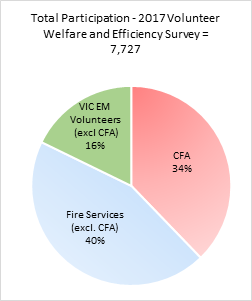
Interim Results: Initial Findings
- Volunteers are most satisfied, and expectations are closest to being met, at a local brigade level.
- Volunteers feel the time they devote to CFA is productive and worthwhile.
- Consultation with CFA volunteers at a Corporate and Regional level is where volunteer expectations are furthest from being met.
- Volunteers would like to see an improvement in the accessibility and flexibility of training, but this has improved slightly since last year.
- Acceptance of Diversity, no barriers to roles women can occupy within the brigade and a welcoming brigade are extremely important to CFA volunteers, and something they feel is done well.
- CFA’s policies, leadership and workforce arrangements which support an effective volunteer based and fully integrated organisation scored poorly, particularly by volunteers with integrated brigades.
- Recruitment and retention of younger volunteers continues to be seen as a challenge.
- Results for respondents who indicated they are members of rural brigades recorded the highest performance results in all themes.
- There is not a lot of difference in the results between the different genders, but females scored statements relating to brigade level slightly worse than males.
- Respondents identifying as volunteer members with integrated brigades recorded the lowest results across the themes, particularly in the theme “People Management – My Brigade”
- The only exception was in the area of Training, where respondents from urban brigades were less satisfied.
- The only exception was in the area of Training, where respondents from urban brigades were less satisfied.
- Respondents to the survey with less than one year of service were most satisfied. This satisfaction dropped significantly after one year, and then again after five years.
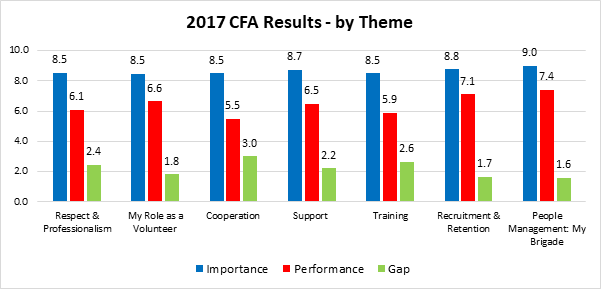
Interim Results: Satisfaction
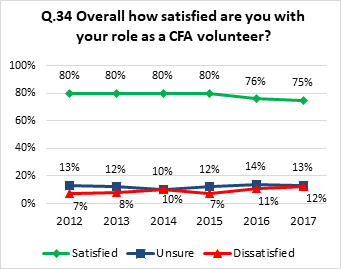
The overall number of volunteers satisfied with being a CFA volunteer continues to decline.
Volunteers with Integrated brigades are significantly less content with only 57% indicating they are satisfied. 78% of volunteers with rural brigades and 74% of volunteers with urban brigades indicated they are satisfied.
70% of volunteers who identified as brigade members are satisfied, compared to 79% who identified as being in leadership roles.

Satisfaction with the way volunteers are treated by CFA is showing no sign of improvement and is a figure that should be of significant concern to CFA.
Lower than the overall rating, only 42% of volunteers in broader leadership roles indicated they are satisfied.
59% of females compared to 46% of males are satisfied with the way they volunteers are treated by CFA.
Only 38% of volunteers who identified as members of integrated brigades indicated they are satisfied, with 43% indicating they are dissatisfied. Volunteers with rural brigades showed the highest satisfaction levels for this question with 53% indicating they are satisfied. The number of volunteers with urban brigades who indicated they are satisfied was 42%.
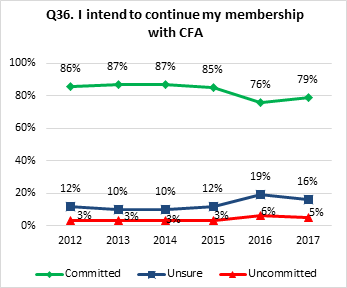
Overall, there has been a slight improvement in those intending to continue their membership with CFA, however the results reviewed by brigade type is important to be understood.
Only 60% of volunteers with integrated brigades indicated they intend to continue volunteerimg, down from 66% in 2016. This is in contrast with volunteers in rural brigades where 82% have indicated they intend to continue (up from 77% in 2016). The ratings for volunteers with urban brigades remains consistent with 2016 at 77%.
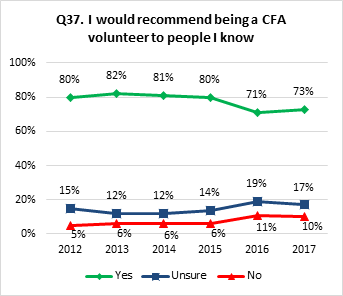
Overall another slightly improved result with an increase in the percentage of volunteers who would recommend being a CFA volunteer to others.
Again, the results of volunteers with integrated brigades being least satisfied is evident here. Only 50% of these volunteers indicated they would recommend being a CFA volunteer to others, this was 61% in 2016. Results for volunteers with rural brigades has increased to 77% now recommending being a CFA volunteer, compared with 73% in 2016. The results for volunteers with urban brigades remains steady at 70%.
Medium Tanker Survey Open
The Medium Tanker survey remains open, and volunteers are invited to provide feedback on the current Medium Tanker build.
An initiative of the Equipment & Infrastructure Committee - the purpose of the survey is to gather feedback from Brigades that have been issued with (or have familiarity with) the Medium Tankers and assess how the cab chassis, locker configuration and base equipment is operating, and if there are any areas of improvement that could be suggested for future builds.
The Committee is keen for feedback from any members who wish to provide their thoughts and experiences of how the Medium Tankers are working in the field.
If you have any feedback or design ideas that you think would benefit future builds – please get involved.
The survey can be found art the top of the VFBV website.
2017 VFBV Volunteer Welfare and Efficiency Survey Interim Results
Written by Adam BarnettNOTE TO MEMBERS – December 2017
Provided in this note to members are initial, high level results only. Further briefings on the results of the VFBV Volunteer Welfare and Efficiency Survey will be provided in the coming months and a detailed report will be published soon.
Background
The VFBV volunteer welfare and efficiency survey has now been conducted for the sixth consecutive year for CFA volunteers. The welfare and efficiency survey is an important tool, used by Volunteer Fire Brigades Victoria, to work with CFA, government and key stakeholders to provide evidence based feedback on matters affecting the welfare and efficiency of CFA volunteers. The survey continues to be valuable in providing feedback on what is going well and where things can be improved.
The survey was developed and introduced by VFBV in 2012. The survey was designed by and for volunteers, to better understand the issues as volunteers see them and to measure and understand how satisfied volunteers are with arrangements in place to support, encourage and enable them to do their work. Fundamental to the survey’s integrity and success is its facilitation and analysis undertaken by their volunteer association.
Who participated
There is very good engagement with the survey and beyond CFA, participation is strengthened by the additional involvement of fire service volunteers in most States, the Victorian State Emergency Service Volunteer Association and other emergency management volunteer involving organisations in Victoria.
CFA Respondents:
- The number of participants in 2017 remains high and provides statistically robust results representing volunteer views – 2653 CFA volunteers participated.
- 2017 had a higher percentage (18%) of female respondents compared to past surveys.
- There was good participation across all age groups, roughly reflecting CFAs age demographic.
- There was good representation from long serving volunteers right through to volunteers who have only been with the CFA for less than a year.
- Most participants (63%) said they are with rural brigades, the balance with urban (29%) or integrated brigades (7%). Less than 1% of those who responded indicated they were members of a CFA Coast Guard brigade.
- Most participants in the survey were either brigade members or leaders within their brigade, with 18% indicating they are in a broader leadership role beyond brigade level.
Preliminary Results: By Theme
33 Welfare and Efficiency Survey statements are grouped into 7 themes (see graph below). For each statement, participants provide a rating on the importance and performance on matters affecting volunteer welfare and efficiency. The size of the ‘gap’ between the two ratings is indicative of how closely volunteer expectations are being met (ie: the smaller the gap, the more closely volunteer expectations are to being met).
Results by theme are consistent with previous years, with no change to themes performing the best or worst.
- ‘People Management – My Brigade’ has the smallest gap of all themes.
- Cooperation across CFA’ has the largest gap of all themes.
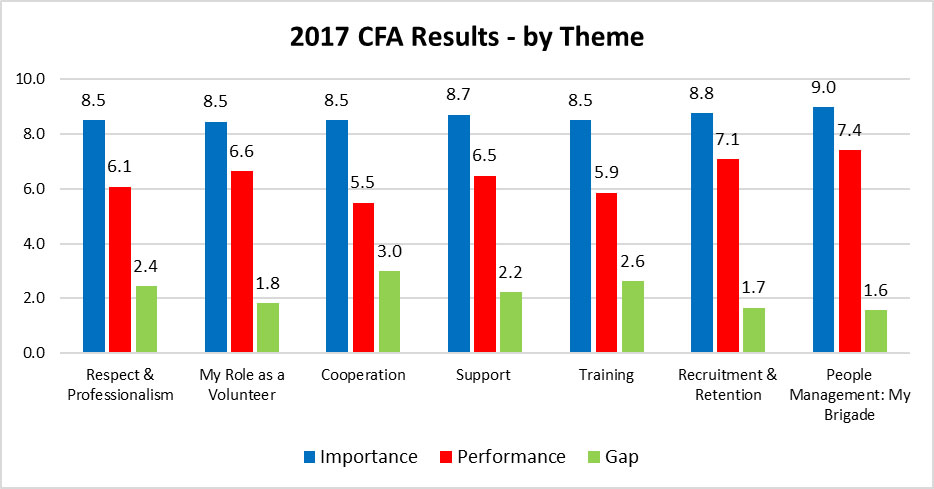
Respondents identified the best performing areas as those which related to matters primarily involving their volunteer activities at a local brigade level.
Respondents judged areas relating to CFA organisational support/management, particularly around consultation and training, as the poorest performing.
Whilst ‘Training’ was again judged as the one of the worst performing areas, results indicate a slight improvement in scores when compared to previous years.
- Results for respondents who indicated they are members of rural brigades showed the highest satisfaction in all themes.
- Results when separated by gender showed little difference. Overall, females tended to rate both importance and performance higher. In most cases, the male respondents’ cohort had slightly worse results than those from the female cohort. The exceptions were ‘Recruitment and Retention’ and ‘People Management’, where the statements were scored slightly worse by females. (nb: the additional gender categories of: transgender; prefer not to say; and, other, only totaled 1.1% of respondents and therefore do not have their results reported separately)
- Respondents identifying as volunteer members of integrated brigades rated performance in all themes the lowest, with the exception of Training.
- Training was rated lowest by volunteers with urban brigades when compared with volunteers from rural and integrated brigades.
- Whilst the theme ‘People Management – My Brigade’ is rated the best of all the themes overall, results for respondents identifying as volunteer members of integrated brigades showed significantly worse results in this area.
- Volunteers who participated in the survey and identified as having leadership roles at a level broader than their brigade tended to be less satisfied with the performance across the themes when compared with those who identified as brigade members or leaders within their brigades.
- The survey responses show that respondents with less than one year of service are most satisfied, but then there is a marked decrease in satisfaction recorded by those with between 1 and 5 years of service. There is a further drop in satisfaction recorded for those in the 6 to 10 years’ service group.
Preliminary Results: Survey Statements
Of the 33 statements in the survey, the below table represents those where volunteers’ expectations are closest to being met.
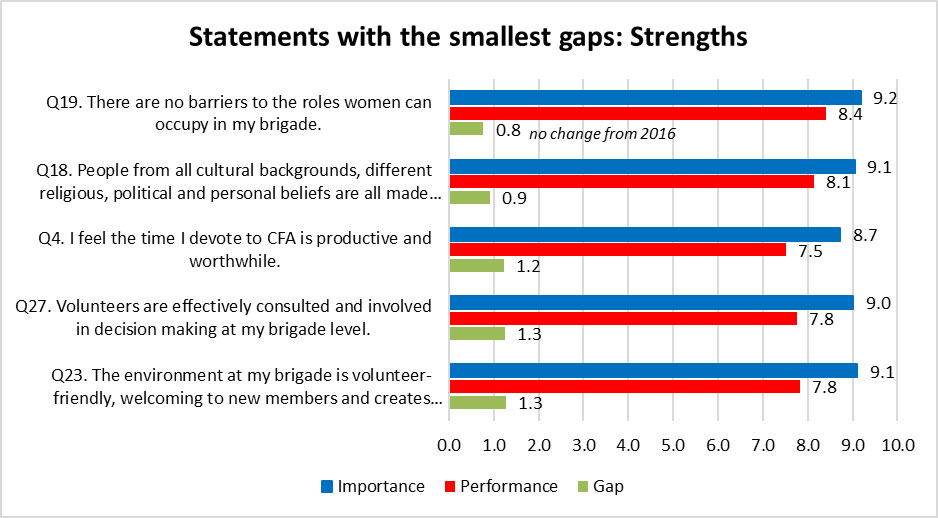
This is a very similar list to last year.
Of the 33 statements in the survey, the below table represents those where volunteers’ expectations are furthest from being met.
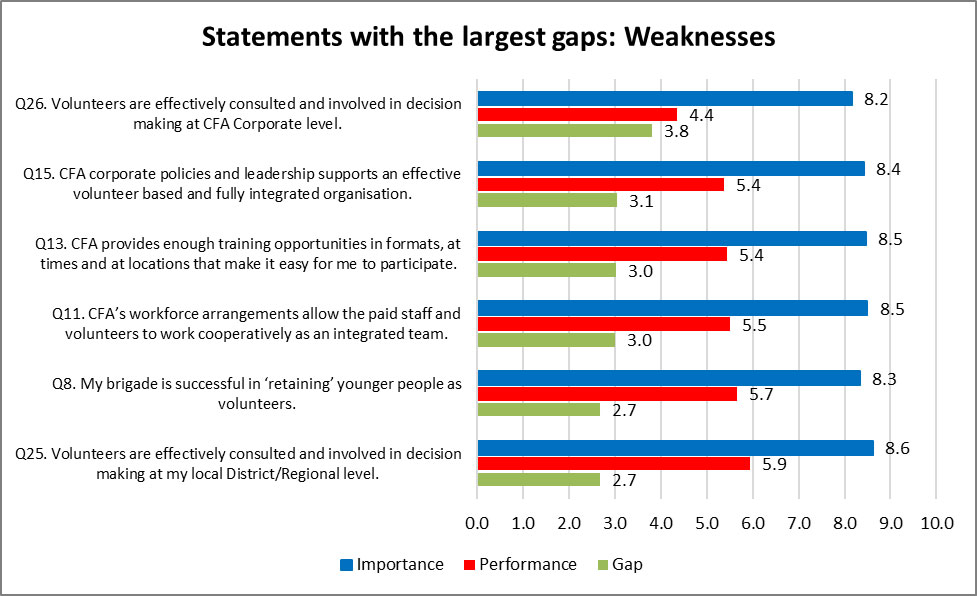
Whilst Q11 has improved slightly on last year, the ratings given by volunteers who identified as being members of integrated brigades worsened significantly.
Statements relating to recruiting and retaining younger volunteers both recorded ratings which indicate performance is declining in this area.
Preliminary Results: Satisfaction
The overall number of volunteers satisfied with being a CFA volunteer continues to decline.
Volunteers with Integrated brigades are significantly less content with only 57% indicating they are satisfied. 78% of volunteers with rural brigades and 74% of volunteers with urban brigades indicated they are satisfied.
70% of volunteers who identified as brigade members are satisfied, compared to 79% who identified as being in leadership roles.
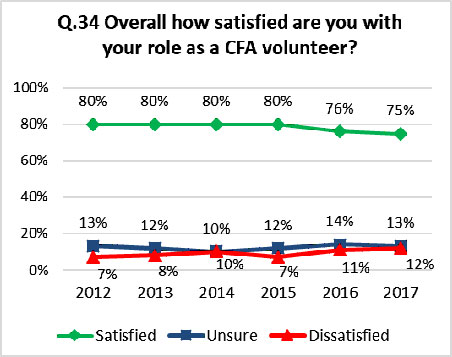
Satisfaction with the way volunteers are treated by CFA is showing no sign of improvement and is a figure that should be of significant concern to CFA.
Lower than the overall rating, only 42% of volunteers in broader leadership roles indicated they are satisfied.
59% of females compared to 46% of males are satisfied with the way they volunteers are treated by CFA.
Only 38% of volunteers who identified as members of integrated brigades indicated they are satisfied, with 43% indicating they are dissatisfied. Volunteers with rural brigades showed the highest levels for this question with 53% indicating they are satisfied. The number of volunteers with urban brigades who indicated they are satisfied was 42%.
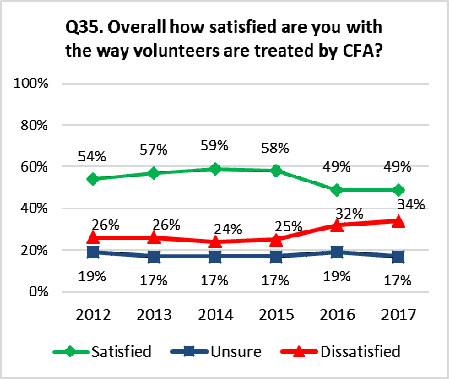
Overall, there has been a slight improvement in those intending to continue their membership with CFA, however the results reviewed by brigade type is important to be understood.
Only 60% of volunteers with integrated brigades indicated they intend to continue volunteers, down from 66% in 2016. This is in contrast with volunteers in rural brigades where 82% have indicated they intend to continue (up from 77% in 2016). The ratings for volunteers with urban brigades remains consistent with 2016 at 77%.
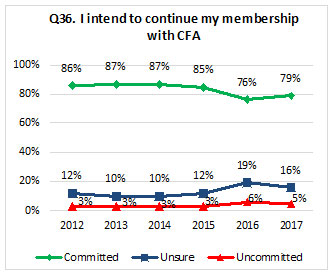
Overall another slightly improved result with an increase in the percentage of volunteers who would recommend being a CFA volunteer to others.
Again, the results of volunteers with integrated brigades being least satisfied is evident here. Only 50% of these volunteers indicated they would recommend being a CFA volunteer to others, this was 61% in 2016. Results for volunteers with rural brigades has increased to 77% now recommending being a CFA volunteer, compared with 73% in 2016. The results for volunteers with urban brigades remains steady at 70%.
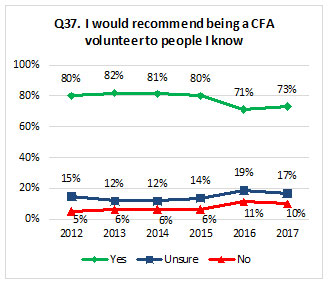
Message from the Victorian Equal Opportunity and Human Rights Commission
Written by Adam BarnettThe Victorian Equal Opportunity and Human Rights Commission has today released the following Statement:
Friday 15th December
Today the Supreme Court provided a decision in relation to the Independent Review into Equity and Diversity in CFA and MFB. The Court dismissed the application of the United Firefighters Union of Victoria and confirmed that the Commission acted within its powers in undertaking this work.
This decision means that we can publish the report of the Independent Review and that the voices of people who have spoken up will be heard. We know that this has been a long process which has had an impact on a number of people. Again, the Review thanks participants for their courage and patience in waiting for this outcome.
We will now undertake the few final steps required before publication. The Review is also required to ensure that any people or agencies specifically referred to have the opportunity to consider and respond to any comments in the report. While the Review will consider any responses provided during this process, final decisions in relation to the report content remain with the Commission.
Should you wish to speak with the Independent Review team, please contact This email address is being protected from spambots. You need JavaScript enabled to view it.';document.getElementById('cloakf4edb8e8924d1d7a34b1df979658db2c').innerHTML += ''+addy_textf4edb8e8924d1d7a34b1df979658db2c+'<\/a>'; or on 9032 3464. If today's court decision has raised any wellbeing issues we encourage you to access the support services available to participants: http://www.victorianhumanrightscommission.com/EDR/index.php/protecting-your-well-being
We look forward to publishing the report in January 2018.
More...
CFA Funding Cut a Kick in the Guts for Volunteers
By Andrew Ford, VFBV Chief Executive Officer
If you are reading this you probably already know that last month, CFA withdrew funding support for FIRE WISE without any consultation and without any regard for what it means for volunteers. And you will also know how important this publication is as an opportunity for CFA the Government, VFBV and others to communicate with volunteers, and how important it is for volunteer views to be shared and expressed respectfully and constructively without censorship or fear of payback.
By way of background, since 1970 CFA has paid a small annual funding grant to support this volunteer focussed publication in recognition of the important role it plays in volunteer communication and consultation. And in the 25 plus years that I have been involved with CFA, this publication has always been used by CFA as one of the most important means of communicating with volunteers - if anything the small annual grant might have been too little, but it was never too much.
The small funding grant from CFA to FIREWISE has helped keep the cost of volunteer subscriptions down and helped ensure broadest possible circulation to CFA brigades, volunteers and friends of CFA across Victoria. And when I say small annual grant, I mean small – the CFA annual grant last year equated to about $4 per brigade per month.
The FIRE WISE newspaper and The Fireman newspaper before it, have been an integral part of CFA’s ability to communicate with and hear from volunteers on the ground since the creation of CFA.
Everyone talks of the CFA family, the big family spread across Victoria. And most of us know that ongoing two-way communication, sharing stories and conversation, feeling included, celebrating successes and heartache, staying in touch with news, feeling connected even when we are far apart, and feeling that our views have been heard and listened to are really important elements of keeping that sense of belonging, pride and commitment going.
So to say I am disappointed to hear that CFA has decided to withdraw funding to FIRE WISE is an understatement.
CFA’s withdrawal of funding is a big and sudden departure from the history of a close partnership type relationship between CFA and the FIRE WISE publication, and The Fireman before it since the formation of CFA. Until last month CFA was listed as an ‘Official Supporter’ of FIRE WISE and for many decades this monthly publication, issued to CFA brigades throughout Victoria, was regarded by CFA as an ‘Official Publication of CFA’. Gordon King, editor of FIRE WISE has proudly reminded us that this close relationship has never reduced the editorial independence of this important volunteer focussed publication and at the same time there has never been an instance when the newspaper’s editorial staff censored or restricted any messaging from CFA or the government regarding their various organisational, policy or change announcements.
CFA’s decision to suddenly cancel its small funding support to this valuable volunteer communications tool, with no explanation of the logic, no consultation with volunteers and no regard for what it means for volunteers demonstrates a growing attempt to block and prevent volunteer’s views being heard. This is just one more step in the gagging of volunteers right and ability to have a voice.
The cost of CFA’s support to FIRE WISE is a tiny fraction of the CFA’s budget and an even tinier fraction of the volunteer connection, motivation, goodwill and sense of belonging it helps create.
This is another sad step in sapping the spirit from CFA volunteers and a disregard for fundamental things that help keep volunteers motivated. CFA’s annual financial contribution to FIRE WISE was approximately $5000 per month. This small contribution helped keep the cost down for volunteers and brigade subscriptions and was a recognition that for many decades CFA has recognised and used the FIRE WISE newspaper as a key volunteer communications vehicle.
Many volunteers have said to me that volunteers should demand CFA provide adequate funding to support an independent communications medium for volunteers as part of the bargain for volunteers contributing their time. The critics that suggest CFA shouldn’t pay anything and that volunteers should have to pay forget that it is volunteers who make CFA what it is and that the value of services provided by volunteers is more than $ONE BILLION every year. Yes, CFA’s own estimates calculate that CFA volunteers contribute service to Victoria worth more than $1,000,000,000 (one billion) every year and yet claim they can’t see the cost benefit of a measly $60,000 funding that helps volunteers across Victoria share news, ideas, innovations and views.
This is an appalling disregard for volunteers and the contribution volunteers give to making CFA the wonderful organisation it is today. Many volunteers have already expressed their frustration that this is just another way of CFA shifting cost back to volunteers – CFA’s financial contribution helped keep the cost of this publication low for volunteers who currently pay for their monthly subscription.
All supporters of FIRE WISE and the principle of volunteers having the ability to speak freely, to share ideas and have a voice are encouraged to voice your concern regarding the CFA’s withdrawal of support for FIRE WISE and join VFBV’s campaign to ensure FIRE WISE survives.
If you are talking to people outside CFA, explain to them how CFA works, explain the value of services provided by volunteers and explain that the cost of CFA’s annual financial support to FIRE WISE is about 2 cents a year from the average household Fire Service Levy.
I have given FIRE WISE editor Gordon King my commitment that VFBV will work with FIRE WISE to find a way forward whatever this requires. Our immediate priority will be to ensure this vital communication and consultation mechanism survives, our next step will be to achieve a more sustainable financial footing into the future and safe from the threat of someone simply cutting the funding supply because they don’t like what volunteers have to say. I can assure volunteers that we will not let this issue go away without satisfactory resolution.
Volunteers deserve a voice and FIRE WISE is part of that voice – it is a publication for volunteers by volunteers, it should be applauded, supported and encouraged by CFA and Government not kicked in the financial guts.
WHAT CAN VOLUNTEERS DO
- Communicate your concerns via emails and letters to CFA, your local MP and via broad public messaging through your local networks and friends.
- Maintain your subscriptions to FIRE WISE and take up the offer of free electronic access
- Be ready to join future campaign effort to raise the awareness of the importance of volunteers having strong, volunteer driven, communications and consultations opportunities because I know the funding cut to FIRE WISE is not going to be the only challenge our volunteer voice will be confronted with.
- Help use this disappointing action by CFA to make the volunteer voice and FIRE WISE publication even stronger - send in your letters of support now and make a future habit of sending in articles of interest and issues for open conversation to FIRE WISE.
- Stay tuned for further developments and be ready to join further action to ensure the voice of volunteers is heard, respected and supported.
Volunteer Trainer & Assessor: Good Progress
Volunteer delegates from the VFBV/CFA Joint Training Committee attended a full day Volunteer Trainer & Assessor Forum arranged by CFA to engage with a small reference group of volunteers, staff and management from the Training department to workshop a series of high level key issues regarding the process and practice of volunteer trainer and assessors, and what could be done to build and improve capability and support for this vital role.
The forum covered topics such as: the role; expectations; scope; mentoring; endorsement; resources and validation processes. EO Adam Barnett praised the initiative and thanked the management and staff in attendance on behalf of the volunteer delegates and VFBV.
The forum was very well run, and the commitment and time dedicated to the day by the staff and volunteers out of their busy schedules to make time for the forum was inspiring and deeply rewarding. Discussions were open and frank and the respect between all stakeholders was evident throughout the day as volunteers and staff collaborated and discussed the different perspectives. Participants workshopped a high-level conceptual framework and partnership with the intent to progress a much improved and robust strategy to build, support and nurture volunteer trainers and assessors across the State.
VFBV wishes to thank DCO Paterson and Manager Learning & Development David Kearney for arranging and supporting the initiative. The Joint Training Committee have made this project a key priority for development and progress throughout early 2018, with delegates to the Training Committee looking for CFA to address volunteer feedback that has been consistently raised during previous training reviews over recent years. The Committee is hopeful of continued good progress and will keep members updated as the project progresses.
IMT Availability Tool
The VFBV/CFA Operations Committee requested confirmation that the online IMT availability tool that was trialled last year that allows members to indicate their availability for IMT duties via an online portal, was in place for this fire season.
The Chief Officer advised it was, and he had provided direction to OM’s in December last year that it was his expectation that the tool be used by districts to support their IMT planning process.
The Committee was advised that all IMT endorsed members should have access to the tool via Brigades Online, with CFA ICT Services working to improve the uploading of endorsement lists that trigger access to the tool.
Any endorsed members unable to access the tool should escalate the issue through their chain of command so that any access errors can be resolved prior to the Fire Season.
NBN Transition
CFA has identified approximately 150 CFA sites will be transitioning to the NBN by end of this year, with 20 done so far.
When a Brigade/Group location is affected, the Brigade is contacted via the District, and CFA Communications will then liaise with Telstra, NBN Co and the Brigade/Group as the work progresses. Frequently, a CFA Comms person will need to be available in person on the day of the works. CFA Comms are currently working on a FAQ to assist affected locations. Brigades who have arranged their own internet access need to be aware that they will have to liaise with their current Internet Service Provider (ISP) to arrange transfer.
Brigades and Groups should also be aware that once a site is fully switched over to NBN – the loss of power to the exchange can result in all communications (including phones) going offline until power is restored. (This applies for ‘fibre to node’ installations) Brigades/Groups are recommended to adjust their Comms plans accordingly, ensuring redundant communications methods are identified and planned for on pre-plans.
The Joint VFBV/CFA Communications & Technology Committee has requested CFA escalate the issue with EMV in order for a sector wide approach, as delegates felt this issue would also have a significant impact on the general public who may also lose their telephone lines in times of emergency, which has the potential to impact on the emergency warning system etc.
District Training Budget Myth Busting
CFA has advised the Joint VFBV/CFA Training Committee that no members should be hearing that training or access to training grounds is being restricted due to budget constraints.
Delegates were advised that training budgets were all in healthy states and there is sufficient budgets for all reasonable requests for training and access to training grounds, with some budgets being underspent. If your Brigade/Group has not recently approached your District for training access or resources because you have been told “no” in the past – you are highly encouraged to re-approach your local Manager Learning & Development who should now be able to accommodate your request. If you have any issues accessing additional training resources, please raise with your local State Councillors who can assist you.
Manual Reprint
Delegates escalated the issue of a shortage of current Bushfire Firefighter Manuals, with reports of manuals not being available for recent volunteer recruit courses. Some affected Brigades having to resort to requesting members return their old manuals for use by new recruits.
CFA has confirmed an additional re-print of 5,000 manuals has been placed, and was recently received – so manuals should now be available again. If you have any issues ordering manuals, please raise with your local State Councillors who can assist you escalate the issue.
Prepare and Focus
By Andrew Ford, VFBV Chief Executive Officer
Here we are only just getting over last Christmas and its November already.
It is now that time of the year when communities and brigades across Victoria are well into their summer preparedness and whilst brigades continue to deal with the day to day fires and emergencies that occur year-round there is also that anxious air of what is to come in the summer months ahead.
There is always lots of forecasting and different views about what we are in for - but the consensus amongst the experts, fuel loads, dryness and early fires in some parts of the State, are all pointing to this being a serious fire season at the least.
Globally there have been a number of telling reminders and tragic loss of life due to major fires including those in California, Spain and Portugal. Our thoughts and prayers go to those who have lost their lives, loved ones, homes and livelihood and also those emergency service personnel and others who are battling these major fires.
The devastation wreaked by fires such as those in California, Spain, and Portugal are also stark reminders of the often catastrophic impact of fire and the reality that Victoria is one of the most fire prone areas in the world.
For as long as I can remember Victoria has taken pride in the fact that we have one of the greatest fire services in the world thanks to our highly trained and enormous volunteer capacity and because of the existing integrated team of volunteers and paid staff working together and in support of each other as one and as equals.
And yes, I do imply a dig here at the people who want to denigrate it or rip it apart and ask anyone in a position of decision making power to stop and think about what legacy your own decisions and influence will leave in terms of the future sustainability of a thriving CFA. And be clear, I think the current fire service reform plan and attitude of some toward what the CFA is at its core - is heading us in a disastrously wrong direction. Beyond the sadness arising from any life loss or major community devastation, the recent major fires in other parts of the world reinforce my deep concern about the possibility that the reckless proposal to dismantle the CFA may have already triggered a slippery slide that will weaken Victoria’s ability to deal with major emergencies in the future.
I hear it in the voices, and see it in the faces of the many volunteers who share with me their concerns of the low morale triggered by the slippery slide that has started. But – it is not beyond repair. As I have said to many who are wondering why they should keep bothering – for now my advice is to stay patient, keep your resolve, get on with what we do for our communities and also stay vigilant and prepared to redouble our efforts if attempts are made to ram through flawed policy or politically driven restructure of the fire services and particularly if the current flawed legislation proposal is not taken off the table.
Like many volunteers I speak to, I do not look back on the past year with much fondness. It has been a frustrating journey to say the least and I am constantly asked when will the Government take the proposed Fire Service restructure off the table and start genuinely respecting volunteers so that we can get on with focussing on something positive and get on with serving the community as we have done year in year out, day in day out.
Sadly, the reality is that despite the Victorian Government’s Fire Service legislation failing to yet be passed or even considered in detail by the Victorian Parliament Upper House it seems our concerns about the fundamental flaws contained within it have still not been heard by some.
Even though the legislation has barely been debated in the Upper House and despite all indications that it does not have the support required to be passed, the Government has had it listed as an agenda item for each of the recent sittings of Parliament so its fate is still not final.
Regardless of the fact that the legislation has not yet been supported by Parliament, it does look like the Government and CFA are bullishly pushing on with some elements of the reform program and VFBV shares the concern of many volunteers that this this highly inappropriate. The big question is what will it take to bring things back to order and transparent process?
As a long serving volunteer said to me earlier this week “. . there is something very fishy going on and perhaps the recently proposed Royal Commission (into Victoria’s Fire Service) is the only way to truly get to the bottom of it”.
VFBV’s submission to the Fire Services Reform Bill Select Committee Inquiry proposed the best way forward is that the legislation should not proceed nor be supported until it has been subject to a proper, transparent review and impact analysis. VFBVs submission to the select committee was that a proper process of inquiry, problem analysis and solution development, done with genuine engagement and transparency would be the best way to set the foundations for improving culture, trust, respect, leadership and harmony within and across the fire services.
We have said we would welcome such a process and any opportunity to actively participate in it. Certainly a Royal Commission would provide such a process. Based on the discussions I have had with many volunteers, and also from the ‘quiet’ discussions I have with many well regarded paid officers throughout the sector it seems most people agree.
Victoria’s fire services arrangements are so vitally important we cannot afford to get it wrong and the best and most powerful instrument for fair and transparent analysis is certainly a probing and highly focussed Royal Commission.
Whilst some people will be tired of reviews, we are definitely more tired of the games being played and the hidden agendas dragging CFA down. And we cannot afford to let tiredness or despair make us give up on the hope of a proper outcome.
The Royal Commission into Victoria’s Fire Service is only a proposal at this stage as it is a policy position of the Victorian Coalition should they be elected next year. Sadly, if a Royal Commission is the only way we are going to remove the ugly politics that has dominated this sad journey then perhaps it is the only answer. I am sure there will be ongoing discussion about this over the coming year.
“A Royal Commission is the only way you will get key people to speak up without fear or without being gagged” is probably the most telling comment I have heard and is a common view amongst most people I have spoken with.
And I agree - let’s get the rubbish off the table; focus now on summer and the work we have to do each day; hold our values; be hopeful that the truth will prevail; and encourage a proper and transparent inquiry, whatever form it takes so that we leave the CFA legacy stronger than we inherited it.
Affiliation Reminder
The number of Brigades affiliating with VFBV for 2017/18 is on track to match and probably exceed last year’s record number, a sign of continued strong support for the association’s work on behalf of volunteers.
A record 95% of Brigades affiliated with VFBV in 2016/17, and this year a number of Brigades have affiliated with VFBV for the first time in many years. If you are not sure whether your Brigade or Group’s VFBV Affiliation and Brigade’s VFBV Volunteer Welfare Fund subscription have been paid, contact your Secretary as soon as possible.
The modest cost of $80 for VFBV affiliation is the same for all Brigades and Groups.
We also strongly encourage Brigades to subscribe to the VFBV Welfare Fund in the interests of supporting your members in times of personal hardship. Last year, the Welfare Fund distributed over $176,000 to volunteers and their families in need. For more information visit the VFBV website www.vfbv.com.au and go to the Member Services area.
For any enquiries, contact your VFBV State Councillors or call us on (03) 9886 1141.
Exciting Course: Places Still Available
District Council’s continue to roll out the VFBV Delegate Development – Engaging Diversity Training course.
The 2 day course is available to all members, including current delegates, aspiring delegates or anyone looking to do some professional development and wanting to increase their leadership and management type skills to enable better Brigade and District Council involvement.
The course has been put together using a blended learning model, combining face to face and out of session work that students can do in their own time at their own pace.
The training will be delivered over two face to face workshop sessions, with a four to six week gap between sessions to provide time for students to complete some out of session work and assignment. Travel reimbursement is available to all participants attending the course.
Feedback from recent participants has been very encouraging.
A recent participant said; “I was a bit dubious about the program to start, but once I got there it was great. I think the interaction and discussion as well as the exercises will help me to fulfil my role in and outside of my brigade duties.”
Another said; “I found the program fast-paced, fun and thought provoking. It was challenging and rewarding to step outside my comfort zone to speak up and engage with others. It was equally rewarding to listen to others and gain different perspectives.
I learned valuable and transferable skills in communication and problem solving. Skills that are vital as a delegate and in everyday life.”
Places are still available, and you can get more information and register for a course by contacting VFBV Support Officer Mark Dryden on 0428 767 258.
This month’s courses are at;
District 8: Sunday 12 November @ Skye;
District 12: Saturday 25 November @ Seymour;
District 23: Sunday 26 November @ Benalla.
Low Voltage Fuse Removal
VFBV has again requested the Chief Officer to urgently escalate the priority of addressing the significantly reduced levels of training in Low Voltage Fuse Removal.
Due to the lack of delivery of courses, and skills maintenance training – the numbers of trained personnel has plummeted from approximately 5,000 to an all-time low, with only a handful of members across the state remaining current.
VFBV has been advocating for many years the importance of this training for the safety of members and reducing the risks of electrocution hazards, as well as address the non-standard, outdated and untested equipment prevalent across the State and inadequate stowage of removal sticks on vehicles.
CFA advised VFBV last year that it had completed and submitted a Business Case to Government for funding of a program to replace untested and dated equipment as well as address the urgent need to re-establish skills maintenance and skills acquisition training across the State.
VFBV investigations reveal this request for urgent funding was unsuccessful and has resulted in the project going nowhere. Given recent grants and funding programs provided to CFA, VFBV has requested CFA to again prioritise this work in the latest rounds of funding.
Delegates have requested the Chief Officer escalate the issue and have the matter addressed as a matter of urgency. The Committee continues to try and inform and advocate to CFA on the serious risks both to members, and the organisation the current situation is resulting in.
Hazardous Tree Management
The Chief Officer has advised he expects all CFA members to complete the Hazardous Tree Management course prior to this year’s Fire Season. Brigades have been posted an Information Package including posters and a DVD.
Brigade Captains can sign off members who have watched the DVD and successfully completed the quick quiz at the end.
Individual members can also complete the package themselves in their own time, by logging into the Learning Hub on Brigades Online.
The Tree Hazard Online course will appear on the homepage. You can complete the online course and the quiz all in the learning hub, and at the end, your training records will automatically be updated to show you have successfully completed the Hazardous Tree Management course.
Medium Tanker Survey Now Open
The Medium Tanker survey is now open.
An initiative of the Equipment & Infrastructure Committee - the purpose of the survey is to gather feedback from Brigades who have been issued with (or have familiarity with) the Medium Tankers and assess how the cab chassis, locker configuration and base equipment is operating, and if there are any areas of improvement that could be suggested for future builds.
The Committee is keen for feedback from any members who wish to provide their thoughts and experiences of how the Medium Tankers are working in the field.
If you have any feedback or design ideas that you think would benefit future builds – please get involved. The survey can be found here.
Hoarding
People with hoarding behaviour live with a higher risk of starting a fire or being trapped in the event of a home fire. Locations of high clutter and hoarding can also pose a risk to firefighters due to the elevated fuel loads and compromised access and egress risks.
CFA informed the Community Safety committee the “Recognising and Reporting Problematic Residential Clutter” poster was finalised, along with a corresponding Operations Bulletin that will be going out shortly. The poster provides nine images of a typical residential room with increasing levels of clutter. Each image is sequentially numbered one to nine – with images five through to nine representing high levels of clutter that should be reported.
To assist with firefighter safety when responding to these locations - Brigades can now register individual addresses identified as having high hoarding/clutter activity that will create a note in CAD so future crews responding to those locations will be notified en-route to the incident as well as appending a notification to the ALERT message.
Brigades can report locations with high levels of clutter on Brigades Online. Go to: Fire & Emergencies > Incident Management > Report High Levels of Clutter. Members of the Community Safety team will review and process the incoming forms and will also ensure privacy is maintained when adding a property to the system.
The poster and Operations bulletin also provide additional information on how to identify and respond to locations with high clutter, including safety advice. Brigades are highly recommended to run awareness sessions to educate members on hoarding.
Listening Set Interruption to be Resolved Shortly
Written by Adam BarnettCFA has advised that due to a small network reconfiguration which occurred on Thursday afternoon, that listening sets have been unable to pick up communications. The issue has now been identified, and the network configuration that caused the problem is due to be rolled back tomorrow (Tuesday). This will fix the problems, and listening sets will then work as they should.
The issue was caused by a change that was using a proprietary standard that was not part of the official P25 standard.
A software update for the scanners will be made available early next year so that any future changes to the network won't cause the problem to re-occur. The Joint VFBV/CFA Communications Committee had also requested that an update file be made available to address all the recent changes to CFA channels - so we have requested this update be rolled into that one, so that members will need only apply one software update.
We will advise when the software update is available along with instructions on how to apply it as soon as its available.
In the short-term, you don't need to make any changes on your end. All functionality will return to normal tomorrow once the network change has been rolled back.
The Medium Tanker survey is now open until the 31st January 2018. This survey is an initiative of the Equipment & Infrastructure Committee. The purpose of the survey is to gather feedback from members and Brigades who have been issued with (or have familiarity with) the Medium Tankers and assess how the cab chassis, locker configuration and base equipment is operating, and if there are any areas of improvement that could be suggested for future builds.
The Committee is keen for feedback from any members who wish to provide their thoughts and experiences of how the Medium Tankers are working in the field and help identify future improvements.
Your feedback will greatly assist with the Committee’s advocacy to CFA, Fleet and Engineering about future improvements to the truck.
Your personal details will not be shared with CFA without your permission – and comments and responses will not be attributed to individuals, and will only be reported on an aggregated basis, so that specific comments or responses cannot be linked back to you or your Brigade.
To complete the survey, please visit: https://www.surveymonkey.com/r/cfamediumtanker

